Home » Search results for 'George Longden'
Search Results for: George Longden
Woodbine Cottage, 14, & 16 Bollington Road
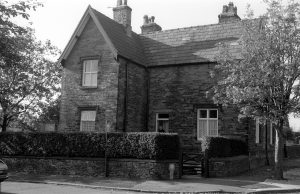 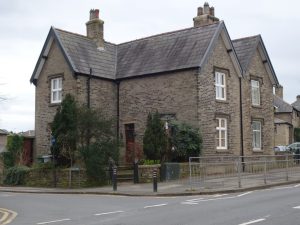 |
Situated directly across the road from Bollington Cross School were numbers 14 and 16 Bollington Road. Number 14 was called Woodbine Cottage on the 1911 census, and was also known as the Schoolhouse probably because Headmaster of Bollington Cross school Herbert Sutton and his family lived there for many years.
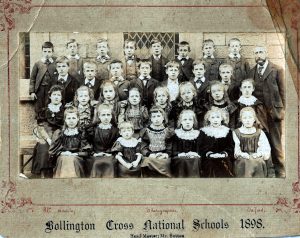
Originally Kingsway the road on the left in the photographs above, was absent as it wasn′t built until around 1930. So the garden to number 14 was large, covering Kingsway entrance and coming right up to the road edge at the front with mature surrounding hedge and trees. Photos of the Sutton family in that garden can be seen on the Bollington Photo Archive website![]() .
.
Census
For number 14 which is the left side of the house as seen from Bollington Road:
1881: Herbert John Sutton aged twenty five years lived at number 14. Occupation Schoolmaster from Bollington from 1877. He was the secretary of the Horticultural Society from 1885. He also organised the Annual Sports and Flower Show and was Choir Master of St Oswald′s Church at Bollington Cross. Also living with him was his wife Hannah of the same age and from Wiltshire. They had two children at this point, Maud two years and Joseph H. aged one year. Also living with them was Mary Hayward, Hannah’s mother aged fifty five years and from Gloucester.
1891: Ten years later Herbert and Hannah Sutton had four more children, James eight years, Edith C. seven years, Mary L. five years and baby Herbert J. aged just five months. Mother in Law of Herbert senior Mary Hayward was still living with them.
1901: Nothing has changed ten years later apart from their ages of course. Herbert resigned from being headmaster in this year due to illness and died in 1909 aged fifty four years
1911: Joseph Hayward Sutton first born son of Herbert John Sutton is now resident of number 14 with his family. Joseph’s father Herbert John senior died in 1909 whilst still at number 14 (Woodbine Cottage). There is no record on Herbert’s wife Hannah, Joseph’s mother. Joseph is now thirty one years of age and his occupation is Clerk to Master in the Royal Exchange. His wife Elizabeth Blower was twenty eight years old and from Denbighshire and previously living in Ledley Street, Bollington. They had a one year old child at this point named Mary. Elizabeth’s mother Sarah Blower, a widow aged fifty nine years, also lived at number 14 at this time, as did Joseph’s brother Herbert John junior aged twenty years. Herbert was a Mechanical Engineer.
1939: Joseph H Sutton was still living at 14 Bollington Road with his wife Elizabeth with daughters Mary aged twenty eight years who was an insurance clerk, Maud twenty five years, and Bessie twenty years and was a school teacher. Also living at number 14 and about to go and fight in the second world was Joseph’s son Richard aged twenty three years. Richard was a representative in textiles at this time. He married Rowena Mary Bamford in 1941 and lived at 118 Palmerston Street. Richard sadly died on 18th April 1943 when his submarine HMS Regent![]() was lost with all hands while in action in WWII after, it is believed, hitting a mine off the coast of Barletta, Italy. Bollington’s war dead
was lost with all hands while in action in WWII after, it is believed, hitting a mine off the coast of Barletta, Italy. Bollington’s war dead![]() .
.
Maud, Joseph’s daughter, was the last Sutton living at Woodbine until her death in the 1990s.
Census
For number 16 Bollington Road:
1911: Mary Ellen Sutton a sixty six year old retired school mistress and sister of Herbert John Senior lived at number 16 with servant Marion Turner aged twenty three from Bollington. Mary had spent all her life in Church Street Bollington. She finally moved next door to her brother Herbert some time around 1900, sadly he passed away in 1909.
1926: John Harding lived at number 16.
1939: John Harding aged fifty five years was still living at number 16. He was a Chief Clerk at a cotton mill. He lived with his wife Roberta aged fifty years and their family.
In the mid 1900s number 16 was occupied by the Green family, Alf (Alfred) and Nellie (Ellen) and their children Brenda, John, Maurice, Margaret and Janet.
Later number 16 was occupied by the Dankins family, John, Amy and children Pauline and John. The Dankins were still there in 1996.
|
|
Your Historic Documents
Please don't chuck out those historic documents and pictures! Find out why here.
Alfred J King
Industrialist, Councillor and Member of Parliament
The following extracts are from George Longden’s report to the KRIV project[1] ….
Ingersley Vale Mill … by 1878 (27)[2] the long occupation of the mill by the bleaching and finishing firm dominated by members of the King family had begun. The firm appears as Bates & King in 1878 (27)[2] and 1883 (33)[3]; William King & Co in 1887-8 (25)[4]; and A.J. King & Co from 1892 (44)[5]. The firm became part of the Bleachers’ Combine around 1900, but retained its name and management.
Alfred J. King was living at Clough Cottage (formerly Clough House, I presume) by 1890 (45)[6], and may have been effectively in charge by then. Allan Bates lived at the Rookery. Alfred King was the dominant partner and Bates later dropped out. Under A.J. King the firm seems to have been a progressive and expanding enterprise. Various developments had a physical impact on the Ingersley Vale site. The first were the extensions of 1895. The local paper announced that these were to consist of a one storey shed, 82 feet square, to “accommodate a number of calendars used in the process of bleaching”, and a two storey warehouse, 40 feet by 25 feet. These were to be situated south of the mill, built across and to the east of the river – the northern end of the block of buildings which can be seen today [2005, since demolished]. The shed occupied the former lawn of Clough House. The house was demolished, and A.J. King moved to Rock Bank House. It was decided to drive the new machines by electricity, and use electricity to light the whole works (20, 23 Mar 1895, 22 Jun 1895, 5 Oct 1895)[7]. …
 A.J. King lived at Limefield (1898) and became a progressive Liberal member of the Bollington Urban District Council, and played an important role in the completion of the waterworks scheme and in instigating a drainage scheme with a sewage works for the village. He represented Bollington on the Cheshire County Council from 1901 to 1906, and from 1906 to 1910 was Liberal MP for the Knutsford Division [which then included Bollington. See election poster left]. After electoral defeat in 1910 (he was beaten by Col. Sir Alan J. Sykes
A.J. King lived at Limefield (1898) and became a progressive Liberal member of the Bollington Urban District Council, and played an important role in the completion of the waterworks scheme and in instigating a drainage scheme with a sewage works for the village. He represented Bollington on the Cheshire County Council from 1901 to 1906, and from 1906 to 1910 was Liberal MP for the Knutsford Division [which then included Bollington. See election poster left]. After electoral defeat in 1910 (he was beaten by Col. Sir Alan J. Sykes![]() a big noise in the bleaching industry who in 1928 opened the Bowling Green in Ingersley Vale), Alfred King and his family moved to Windermere, where they were visited from time to time by parties of workers from Ingersley Vale (48, p33)[8].
a big noise in the bleaching industry who in 1928 opened the Bowling Green in Ingersley Vale), Alfred King and his family moved to Windermere, where they were visited from time to time by parties of workers from Ingersley Vale (48, p33)[8].
See Ingersley Vale mill for an A. J. King & Co Ltd document.
References
Clicking the reference description takes you back to the text.
- Kerridge Ridge & Ingersley Vale, An Historical Study, George Longden, 2002.
The study document (PDF)
- Greenwood’s Cheshire Map, 1819
- A M Tonkinson, Macclesfield In The Later Fourteenth Century, 1999
- Agreement between George Antrobus and Joseph Wagstaff, fragments, nd, Bollington Civic Society archive, Antrobus collection, no.9. George Antrobus
- Not identified
- Not identified
- Jane Laughton, The Place Names Of Rainow, articles in Contact, the Parish Magazine of Rainow with Saltersford and Forest, January 2000 – May 2001
- Not identified
Your Historic Documents
Please don't chuck out those historic documents and pictures! Find out why here.
Alfred Gatley
Sculptor, 1816-1863
The 200th anniversary of the birth of Alfred Gatley was celebrated on Friday 15th January 2016. A ceremony was held at his birthplace at Spring House in Kerridge, when a Blue Plaque was unveiled to his memory.
|
Alfred Gatley was born at Spring Cottage (today known as Spring House), Kerridge, on 15th January 1816. His father owned and worked two stone quarries in Kerridge Hill. Alfred showed very early promise as a sculptor and took this up professionally. He spent much of his career in Rome, Italy, carving in marble. He died on 28th June 1863 at age 47, in Rome, where he is buried. There are many examples of his works in Bollington and the Cheshire and Manchester/Salford area as well as more widely. While the whereabouts of many of those pieces in private ownership were known in the 1960s I suspect that the passage of time will have resulted in some of them being widely distributed and beyond normal search. The late Dr John Coope used examples of Gatley’s work in the displays for the very first of his Bollington Festivals, in September 1964, and in preparation he and Harry Cole did a lot of research into Gatley with a view to writing a biography. Unfortunately the book never materialised but all Dr John’s papers and pictures were most generously donated by his widow, the late Dr Jean Coope, to Bollington Civic Society and they provide the basis of this page. The 200th anniversary of Alfred Gatley’s birth was celebrated by the unveiling of a Blue Plaque on his birth place, Spring House in Kerridge. WorksThis is a very incomplete list of Alfred Gatley’s works, the first part compiled by Dr John Coope and Harry Cole for the 1964 Bollington Festival. The details given are the subject, date of execution, last known location.
The following list is taken from a list of exhibitors at the Royal Academy in 1854. The whereabouts of all except one of these is unknown.
* The Hon. Augustus H Vernon was a member of the Poynton Vernon coal mining family. Other works by Gatley are, or were in recent years, at Lyme Hall; Salford City Art Gallery; St Mary’s Church, Disley; Mottram in Longdendale church. The two bas relief panels known as the Craigentinny Marbles (above right) were described at the time of installation in 1867 as “The most remarkable pieces of sculpture executed during this century.” The original Oak Bank House in Bollington, erected in 1858, had a very fine carved front door surround and frieze (picture right). Dr John Coope believed that this may have been the work of Gatley. Sadly this fine piece was lost when the house was demolished in the 1940s. Alfred Gatley’s 200th birthday was celebrated by the unveiling of a blue plaque (see above right) and the guests were refreshed at the Bull’s Head with coffee and a delicious cream and sponge cake baked and supremely decorated by Paul from Belfield’s Bakery in Palmerston Street.
|
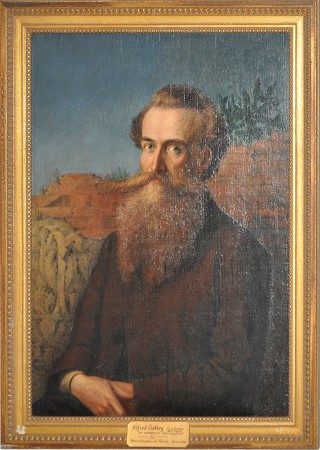 Alfred Gatley, 1816-1863, Sculptor Alfred Gatley, 1816-1863, Sculptor by Marcianno da Tuna, Rome 1862 Shown by the very kind permission of the late Mr Timothy & Mrs Elizabeth Richards of Gawsworth Hall where the painting and other Gatley artefacts can be seen during house tours. 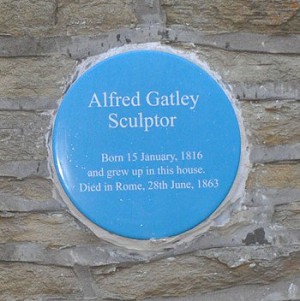 Blue plaque unveiled at his birthplace Blue plaque unveiled at his birthplaceon the 200th anniversary of his birth. 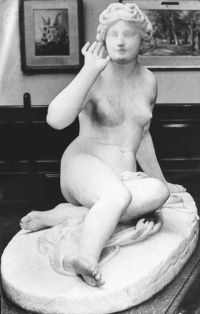 Echo – popular girl! Echo – popular girl!Gatley is known to have carved three of these! This one is on view at Gawsworth Hall. 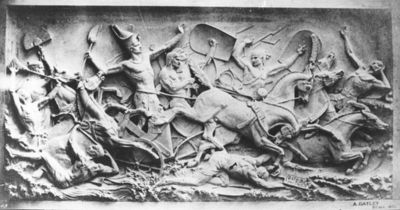 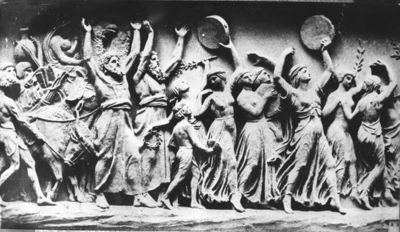 Two bas relief panels known as the Craigentinny Marbles Two bas relief panels known as the Craigentinny Marbles
George Swindells and his wife Elizabeth Swindells
Oak Bank House front door surround (this is not Alfred Gatley standing there!). What a pity that the photograph didn’t include the whole of the door casing. Detail from the picture above.
|
Extract from KRIV report by George Longden1William Broster asserts that Alfred Gatley was born in “the family home”, Gatley’s Yard – though it has to be said that Broster is not very reliable on historical matters outside his own experience [27]. According to the Dictionary of National Biography (DNB) [47], “while still a child [Gatley] learned the use of a stonemason’s tools from his father, who owned and worked two quarries in the Kerridge hills.” Alfred was educated at Rainow School where, tradition says, he carved his first work, his teacher’s head, out of a turnip [35, p.74]. Here, his ability, both artistic and general, was observed by the Rev. J. Sumner, the vicar of Pott Shrigley, who seems to have given him some private tuition alongside his own children [51]. After school he assisted in the family quarry, and here what Broster says was his first sculpture in stone, a figure of Walter Scott’s Tam O’Shanter, was completed. This work came into the possession of the Rev. Sumner, who loaned it in 1839 to an exhibition organised by the Macclesfield Useful Knowledge Society in Macclesfield Town Hall [16, 29 June 1839]. Two years earlier, in 1837, Gatley had moved to London, “aided by a few friends” as the DNB puts it. He worked in the studio of Edward Hodges Baily RA FRS, until in 1843 he became assistant to Musgrave L. Watson. In his early years in London Gatley studied in the British Museum, and then became a student of the Royal Academy, exhibiting there for the first time in 1841. Among works Gatley sold in his London period were figures of Cupid and Psyche, for Martin Swindells of Bollington, the memorial for the jubilee in 1846 of the Macclesfield Sunday School in Roe Street, and a bust of Dr. Sumner, archbishop of Canterbury and brother of the vicar of Pott Shrigley. The bust of Sumner was exhibited at the Royal Academy in 1848, and at the same time a cast of it was on display in Macclesfield Town Hall. The Macclesfield Courier commented that “the success of this rising young artist has been almost without parallel” [16, 15 July 1848]. In spite of a growing reputation, Gatley remained in tight financial circumstances. In 1852 he moved to Rome, where he took a studio on the Pincian Hill. Here, he still struggled to find adequate patronage, as his letters home show. In 1860 the Rev Sumner wrote to Gatley, mentioning an old acquaintance with artistic ambitions; Gatley replied “I certainly pity him if he does not pocket 10 times per annum more than I do” [48]. Gatley’s letters, incidentally, also suggest complex (and contested) Gatley family properties and finances in Kerridge. Gatley exhibited his bas-relief of ‘Pharaoh and his Hosts’ at the International Exhibition in London in 1862. This was to be the occasion of Gatley’s last visit to England; he died from dysentery in Rome on 28 June 1863, and is buried in the English cemetery there (picture above right). The rumour that he was poisoned by jealous Italian sculptors was prevalent in Kerridge for many years. An obituary for Gatley appeared in the Art Journal: “He had a mind of singular independence. The style he chose admitted of no facile compromise of the classic with the pictorial. It descended not to seek an easily purchased popularity by softly blended forms after the manner of the Romantics. The school to which he belonged was stern and strict. The English public failed to comprehend the largeness of his manner” [57]. Alfred Gatley’s diary and letter books and desk, a portrait of Gatley painted in Rome in 1862, a bust of Milton in Kerridge stone (1833), a reclining figure of a young girl, ‘Echo’ (1850), and a bas-relief panel ‘The Triumph of Britannia’, all by Gatley, are listed in Raymond Richards’ Manor of Gawsworth (1974 edition) as being in the Gawsworth Hall collection [49]. ‘Echo’ is illustrated in Richards’ book, as it is in the brochure for the first Bollington Festival in 1964, which also contains a photograph of Gatley, impressively wild in hair, beard and eye [50]. Other works by Gatley are (or were recently) at Lyme Hall; Salford City Art Gallery; St Mary’s Church, Disley; Mottram in Longdendale Church; and Bollington Medical Centre [58]. William Broster, it seems to me, made a good point when he wrote that “it is unfortunate and regrettable that nothing in [Gatley’s] native village remains to perpetuate his memory and outstanding eminence as a sculptor of national fame in the Victorian era” [27]. We have put right the last regret above on the 200th anniversary of Gatley’s birth, 15 January 2016 – see top of page. [Webmaster] |
References in this section marked [nn] … 16. MACCLESFIELD COURIER, microfilm, Macclesfield Public Library 27. William S. Broster, BOLLINGTON & KERRIDGE 1830-1980, 1980 35. W. Norton Betts, BOLLINGTON THROUGH THE CENTURIES, 1934 47. DICTIONARY OF NATIONAL BIOGRAPHY, 1993 ed., vol 7 48. ALFRED GATLEY’S DIARY AND LETTERBOOKS, from a transcript formerly in the possession of Mrs Rathbone, Bollington Cross 49. Raymond Richards, MANOR OF GAWSWORTH, 1974 edition 50. ALFRED GATLEY, KERRIDGE BOY WHO BECAME A SCULPTER (sic), Bollington Festival Brochure, 1964 51. John Earles, HISTORY OF OLD MACCLESFIELD, one of series of articles in the Macclesfield Courier, 31 March 1917 57. Rupert Gunnis, DICTIONARY OF BRITISH SCULPTORS 1660-1851, revised ed (nd) 58. NOTES ON THE WORKS OF ALFRED GATLEY, handwritten ms in hands of Dr John Coope (now in Bollington Civic Society collection) 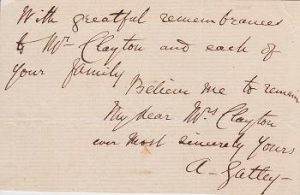 It reads – Believe me to remain Unfortunately there is no date, indeed, the body of the letter appears to have been cut off and discarded. While the Victorians tended to use over flowery text in their writings, it is possible that Mr & Mrs Clayton (probably of Kerridge) were patrons of Gatley and financially supporting him while he was failing to earn enough to live on, which was the case for most of his career. |
Links
- https://www.geo.ed.ac.uk/scotgaz/features/featurefirst8582.html

- https://www.edinburgharchitecture.co.uk/craigentinny_marbles.htm

- Gawsworth Hall – Tudor Manor House with covered garden theatre

Reference:
Clicking the reference description takes you back to the text
Acknowledgements
Thanks to those whose research made these pages possible
We wish to offer the fullest acknowledgement to the Bollington Civic Society Historical Group who spent many years in the 1970s, 80s and 90s researching the history of Bollington, its people, its mills and other industries. The principle historians were George Longden, Molly Spink (who is still active) and Roger Bowling. They were supported by James Hough, Christabel Burgess, G R Alexander, Geoff Coe, Brenda King, David King, A Fearnhead and others. Further later work was carried out by George Longden for the Kerridge Ridge & Ingersley Vale project. We, the people of Bollington, owe them a great debt of thanks for collecting and preserving our historical heritage!
One of their greatest achievements was the collection of more than 5,000 historically important pictures which were so generously donated by the people of Bollington – indeed they are still passing to us most interesting and valuable pictures and documents today (if you have something of interest please see this page). The late Dr John Coope was instrumental in both setting up the Historical Group (as part of his already established Civic Society) and in encouraging the residents of the town, most of whom were his patients, to search out and make available their pictures. These pictures have been digitised and are available for all to search, view and enjoy at the Discovery Centre (a Bollington Civic Society project) and online here![]() .
.
A selection of the history gleaned by this group, together with some of the pictures, were published in various books. Most are now out of print but one, Looking Back at Bollington, has been reprinted and is available at the Discovery Centre or by mail order. The high cost of republishing these books has prevented the Civic Society from making more available. However, the internet and the Happy Valley web site provide an affordable means of making the material available to a wider public.
I also acknowledge the work of the Wilmslow Historical Society Industrial Archaeology Group who researched the cotton industry in Bollington and published their findings in Cotton Town, Bollington and the Swindells family in the 19th Century. I regret that the last of these has now been sold but copies do occasionally turn up on eBay.
Much of the historical information exhibited in these pages comes from the researches of those mentioned above with additional material from a wide variety of people, both town residents and those who have moved away, and from correspondents who have taken an interest in the web pages and provided their own information. Very many thanks to them all. The history of Radion’s Ltd. was researched and written by Ian Macwhirter to whom I am most grateful for permitting its publication here.
Much of the more recent (2010s) research into families and their houses has been carried out by Linda Stewart who was born and brought up in the town and has returned to live nearby. She has been assisted by many householders, keen to share the history of their family and property. We thank them all.
Paper industries
Rainow paper mill
Backhouse & Coppock | Tullis Russell | Slater Harrison
George Longden wrote in his Historical Report for KRIV[1] …
The paper mill was on the site of Rainow Mill [in Ingersley Vale by Mill Lane where the green shed is today], which had been a corn mill in 1611. I can find no reference to the history of the mill between 1611 and the late 18th century, by which time it had become a paper mill. The Bollington Civic Society archive includes part of a document by which Joseph Wagstaff granted permission to George Antrobus to dam the stream above Antrobus’s cotton mill [Higher Mill], provided that the level of the water was not raised above that at the bridge “near the said Joseph Wagstaff’s paper mill” (10). The document is undated, but probably dates from the early days of Higher Mill, which was founded in 1789 or 1790 (see below).
The Rainow land tax returns describe Rainow Mill as being in the ownership and occupation of Joseph Wagstaff between 1794 (the first year in which the returns name the properties being taxed) and 1796. From 1797 to 1802 (the last year in which properties were described) it was owned and occupied by Lawrence Wagstaff (11).
A deposition of 1806 by a Rainow millwright, William Richardson, tells us that the paper mill was converted to a cotton spinning mill in 1801 by Lawrence Plant Wagstaff and his partner William Watts (12).
References:
10. Kenneth Cameron, ENGLISH PLACE NAMES, 1961
11. Jane Laughton, SEVENTEENTH CENTURY RAINOW, 1990
12. Walter Smith, RAINOW IN THE OLDEN TIME, articles in the Macclesfield Courier, 1932-3
Backhouse & Coppock Ltd
This company of paper makers was founded in Castleton, near Rochdale, by Major George Backhouse. In 1876 they moved the business to Bollington, but I don’t yet know which mill they occupied. George Backhouse and his family lived in Shrigley Road, which suggests that his mill was at this end of the village. While here Major Sidney Coppock joined Backhouse in partnership and the company name changed. Later the Major’s son Lieutenant Colonel Henry Backhouse (born 1873 near Rochdale, died at sea off Crete, 30th December 1915) and stepson Mr George H Mason joined the business. They then moved the business out of Bollington to Pickford Street, Macclesfield, and later still to Sutton Mill in Oxford Road, Macclesfield. See Macclesfield Reflects![]() for more information about the life of Henry Backhouse.
for more information about the life of Henry Backhouse.
This company specialised in coated papers and pasteboard. It would be interesting to know whether this firm actually made paper in Bollington or whether it took in stock and further processed it. Paper making requires a great deal of water and I suspect that our rivers would not have provided sufficient for such a process.
The main products were embossed, fancy and enamelled papers and cards. Very similar, in fact to the products of the two paper coating companies in Bollington today – Tullis Russell and Slater Harrison. It is interesting to note that while these latter two have been in Bollington a long time, they were not the original paper coating businesses in Bollington.
As we say, what goes around comes around. In 1926 Backhouse & Coppock were taken over by the Inveresk Paper Co., of Edinburgh, who were at the time accumulating many small paper companies in order to consolidate and dominate the industry, together with a number of paper users such as newspaper and periodical publishers. Backhouse & Coppock continued to operate at Sutton mill in Macclesfield until April 1981 when Inveresk advised that they intended to close the Sutton mill business. A smaller and more versatile business, named Coated Papers Ltd. (CPL), was drawn out of the staff and processes at Sutton mill and established in the disused Brittains paper mill at Cheddleton, near Leek. In February 1984 CPL was bought out by Tullis Russell, so re-establishing their connection with Bollington! An aside – Shrigley Dyers established for more than 60 years in Higher mills also, in the late 1990s, relocated to part of Brittains Cheddleton mill!
Tullis Russell
Lower Mills (pictured below) is the home of Tullis Russell![]() (TR), one of the major employers in Bollington. This employee owned company, actually based in Scotland, takes in paper and card stock and processes it to add coatings for a wide variety of purposes. For example, they apply the glue to the back of stamp paper which is supplied to many countries all around the world. In 1984 TR acquired Coated Papers Ltd. of Cheddleton – see section above.
(TR), one of the major employers in Bollington. This employee owned company, actually based in Scotland, takes in paper and card stock and processes it to add coatings for a wide variety of purposes. For example, they apply the glue to the back of stamp paper which is supplied to many countries all around the world. In 1984 TR acquired Coated Papers Ltd. of Cheddleton – see section above.
Slater Harrison
The present company was established in 1929 (company history![]() ). Today they are housed at Lowerhouse Mill at Lowerhouse. They process paper and card stock by adding coloured coatings, often shiny or fluorescent, particularly for the retail display industry – promo boards and signs in shops.
). Today they are housed at Lowerhouse Mill at Lowerhouse. They process paper and card stock by adding coloured coatings, often shiny or fluorescent, particularly for the retail display industry – promo boards and signs in shops.
An earlier company, Henry & Leigh Slater, was incorporated in 1888, and were located at Lower Mills, where Tullis Russell are today, around the turn of the 19th and 20th centuries. See below their advertisement from the British Printer magazine of the late 19thC showing a fine engraving of the mill at the end of Church Street. There is some artistic licence in the form of the surrounding hills!
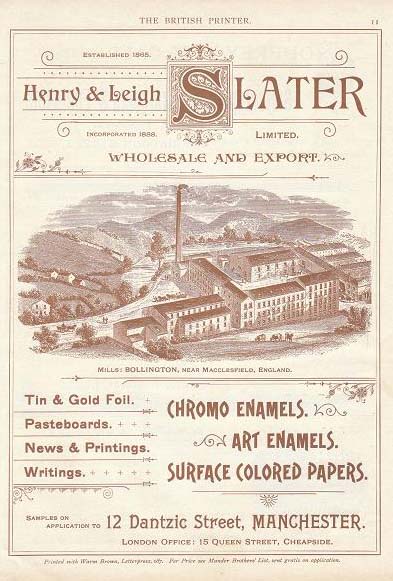
Reference
- Kerridge Ridge & Ingersley Vale, An Historical Study, George Longden, 2002.
The study document (PDF)
Your Historic Documents
Please don't chuck out those historic documents and pictures! Find out why here.
Waterhouse Mill
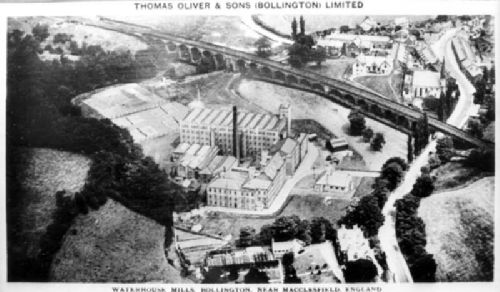 Waterhouse mill was first built by 1791 by Peter Lomas (pictured below). It didn’t survive many years, being burnt down in 1800. It was rebuilt and became the premier fine cotton mill in the country.
Waterhouse mill was first built by 1791 by Peter Lomas (pictured below). It didn’t survive many years, being burnt down in 1800. It was rebuilt and became the premier fine cotton mill in the country.
Cotton spinning ceased on 5th August 1960 and most buildings were demolished in 1962, leaving only the single story office used for 50 years since as the reception office, the recreation pavilion and a small shed.
Modern buildings were then erected on the site for Kay Metzeler who made foam blocks for the motor, aircraft, furniture and other industries. The foam was used for components such as seats. Kay Metzeler closed their mill by the end of 2012. The site was then sold to Bellway, housing developers, who obtained planning permission and started construction in early 2014. In readiness, contractors demolished all buildings on the site and all the underground remains of the original mill were dug up and removed. More than 10,000 cubic metres of fill were brought in from the tram construction project at Manchester airport to raise the ground level, ensuring that the new houses are well above the possible high water level of a flooding river Dean.
 The mill was originally water powered using a large wheel. Water was extracted from the river Dean at the weir behind the end cottage (23 Adlington Road) alongside the Recreation Ground. The water passed along a wide leat, under the railway viaduct (though the leat came before the railway), into a mill pond, which has long since been filled in (see the picture above). The water drove a c.23ft diameter wheel between 9 and 10 feet wide – a substantial wheel. The used water was then routed through a long sough (culvert) to the river, near to Garden Street bridge. During the demolition of the modern buildings, the original wheel pit and the sough were all removed.
The mill was originally water powered using a large wheel. Water was extracted from the river Dean at the weir behind the end cottage (23 Adlington Road) alongside the Recreation Ground. The water passed along a wide leat, under the railway viaduct (though the leat came before the railway), into a mill pond, which has long since been filled in (see the picture above). The water drove a c.23ft diameter wheel between 9 and 10 feet wide – a substantial wheel. The used water was then routed through a long sough (culvert) to the river, near to Garden Street bridge. During the demolition of the modern buildings, the original wheel pit and the sough were all removed.
The engraving above is an artist’s impression of the mill in the 19thC. The point of view lies approximately where the Arts Centre driveway is today, so the view must have been taken before the railway was built in 1868. The image clearly shows the mill pond (light stripe across the middle) and dry land this side of it (click on the image for a bigger view). There may, of course, have been some artist’s license incorporated into such details! The image comes from a Thomas Oliver & Sons invoice dated 1914. It was common in the 19th and early 20th centuries to include images of company properties, mills, factories, on headed documents.
The best history that we have of Waterhouse mill was discovered on eBay and acquired for the Civic Society. The transcript follows …
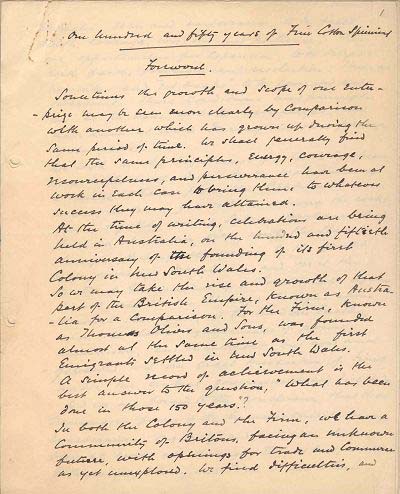 —— Editor’s introduction ——-
—— Editor’s introduction ——-
The following material on Waterhouse mill and the firm of Thomas Oliver & Sons Ltd. is taken verbatim from the History written by the Revd. A. C. Oliver. This has been transcribed from the original handwritten pages (right) by Jaqui Parker to whom I am most grateful, with subsequent editing by myself, the webmaster. There were a few words that we could not determine and these are shown as —–. Very few changes have been made to the words and only where clarification is required and these are marked by curly brackets {}. Comments in round brackets () and gaps in the text ____ are those of the original author. Web links have been added where additional information can be found elsewhere. There is extensive use of pre-decimal currency. For those unused to this please see the Wikipedia guide![]() .
.
The pages came to us in a loose leaf file, un-numbered and not necessarily in the sequence intended by the author. I have therefore ordered them to provide, in my view, an appropriate flow of the story. The pictures referred to in the text were not provided with the text. I have therefore included a selection from the Bollington Civic Society Discovery Centre historic picture collection.
————————————
Thomas Oliver & Sons (Bollington) Ltd.
Notes, Compiled by Revd. A. C. Oliver
on the History of the Firm during 150 Years, dated February 1940.[1]
One hundred and fifty years of Fine Cotton Spinning
Forward
Sometimes the growth and scope of one enterprise may be seen more clearly by comparison with another which has grown up during the same period of time. We shall generally find that the same principles, energy, courage, resourcefulness, and perseverance have been at work in each case to bring them to whatever success they may have attained.
At the time of writing, celebrations are being held in Australia, on the hundred and fiftieth anniversary of the founding of its first Colony in New South Wales. So we may take the rise and growth of that part of the British Empire, known as Australia for a comparison. For the Firm, known as Thomas Oliver and Sons, was founded almost at the same time as the first Emigrants settled in New South Wales. A simple record of achievement is the best answer to the question, “What has been done in those 150 years”?
In both the Colony and the Firm, we have a Community of Britons, facing an unknown future, with openings for trade and commerce as yet unexplored. We find difficulties, and obstacles, seen and unforeseen, to be faced with courage, wisdom and patience. These are opportunities for expansion, work seized with faith, foresight and resolution,. There are mistakes and “set backs” to be corrected and overcome. These conditions and principles are at the base of both enterprises, and have been at work during the slow passage of the years.
We look at the beginnings of a little business, in a little mill, driven by the waterpower of a small stream from the peakland moors. Again, we see a few settlers, among the rocks, scrub, and gullies round Sydney Harbour. And then we shift our view, with speed of thought, through the years, to the great self-governing Dominion, and see it the centre of Government of a continent. Again we look, and see the change brought about through the years, to the modem factory with the latest equipment of power, machinery, and transport, but now amalgamates into one great Association of Firms under our central government and direction. And we are forced to the conclusion that those tremendous forces of the human spirit, courage, perseverance, sagacity, and patience have been at work all through, till, at last, both enterprises, Colony and Firm stand where they are today.
All this could only have been done by the co-operation of “all hands”. In both, Colony and firm, there must have been a willingness to adapt and re-shape in the face of new conditions and circumstances. And each entity, the Colony and Firm, have kept its own individuality. The early Colony may have been merged with others, as they have sprung up, into the Commonwealth of a great Continent. The Firm may have been amalgamated into one great “Association of Fine Cotton Spinners and Doublers”. But each concern retains its own individuality, which contributes to the success of the whole. Both Colony and Firm have been listed in the hundred and fifty years of their existence, by those “two impostors success and failure”, and have learned how to “treat them both the same”, as Rudyard Kipling, the great poet of Empire, has it. There has been the early flush of success and expansion, (by the discovery of the goldfields) on the one hand, and there have been lean years, some filled by wars and loss, and even famine. And yet, with that instinct for righteousness, which is the strength of all, both have emerged to celebrate a great achievement and with that vigour and strength which are still needed, when Empire and Nation, Colony and Firm, may need all the resources of mind and body, to face the constantly shifting problems of the world today. We may close this introduction with some lines of the poet Whittier (a few words altered)
“But through the drive
“Of its loud life, hints and echoes of the time behind steal in;
“And love of Colony and nation, E’en the factory’s humming rhyme
“Point the path of truth and duty to each true man of the time”
The rise of the Great Republic of the U.S.A. began at the same time as the Firm, and the Colonies of Australia. Its growth was, of course, marked by the same qualities of courage, tenacity of purpose and perseverance as they were; but I have preferred to take the British Continent of Australia as a parallel for the history and progress of the Firm.
A. C. O.
The History of Bollington and the Mills
Bollington is a parish in the Forest of Macclesfield and in the ancient Parish of Prestbury, which at one time included even Macclesfield. Strangely enough, the River Bollin from which it most probably derives its name, does not come nearer to it than two miles, and it is really situated {on} a little river called the Dean. The village lies in a lovely valley, at the foot of the hills rising into the Peak District of Derbyshire.
An undoubted Roman road is marked on the map in Codrington’s “Roman Roads {in} Britain”, running from Manchester, through Levenshulme (this part is still called “High Street”) and on to Stockport and Hazel Grove. From there it went on to Aquae (Buxton). The historian Whitaker mentions a Roman road going on through Adlington, and an old ordnance map shows a “Roman Road” going over Billinge, in which case, Bollington has a connection with the times of the Roman occupation of Britain. In any case, before the Macclesfield canal was brought through the village in {1831}, or the Railway in 1870, it was partly along the Hazel Grove to Manchester road that loads of raw and manufactured cotton were carried by horse and cart, at a cost of from 4/- to 6/8 per load.
In 1353, the Manor of Bolyngton was in the hands of the Black Prince. This passed on to Queen Isabella, and she granted the mill of Bolyngton to William de Shirborne for life. He enjoyed this only a few months, and then the Black Prince granted it to Robert of Plumstoke his yeoman and barber for life. It then passed to William Soty a yeoman for life.
These were troublous times, and in 1354 this mill was nearly in ruins. However, in 1358 the Black Prince visited “his manor and mill of Bolyngton”, and he ordered the gift of “two oaks fit for timber, from his Forest of Lyme”, to William Soty for the repair of his mill of Bolyngton”.
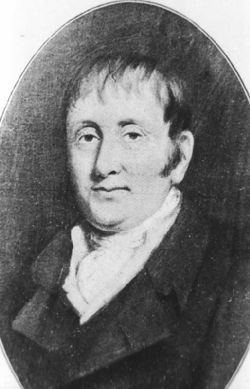 Bollington Hall is near to where this old mill was situated {The mill referred to above was almost certainly that which stood in Ingersley Vale on the site of Rainow mill before that was built. The corn mill behind Bollington Hall Farm was built in the 16thC}. And in the passage of time it is believed that Elias Lomas and his brother Peter Lomas (b.1750 d.1822) {right} came to live there. Near by there was a tanyard owned by the two brothers on the site now occupied by the house and garden known as “Brook House” But after some years, they saw the possibilities of another business which was springing up in the North of England – cotton spinning. At the other end of the village there was an old building, which had been a brewery, as far back as 1662 {but we are very unclear about which building or where this might have been}.
Bollington Hall is near to where this old mill was situated {The mill referred to above was almost certainly that which stood in Ingersley Vale on the site of Rainow mill before that was built. The corn mill behind Bollington Hall Farm was built in the 16thC}. And in the passage of time it is believed that Elias Lomas and his brother Peter Lomas (b.1750 d.1822) {right} came to live there. Near by there was a tanyard owned by the two brothers on the site now occupied by the house and garden known as “Brook House” But after some years, they saw the possibilities of another business which was springing up in the North of England – cotton spinning. At the other end of the village there was an old building, which had been a brewery, as far back as 1662 {but we are very unclear about which building or where this might have been}.
This they rented, and established there a business which, not many years after, became known as “Thomas Oliver & Sons,” for Thomas Oliver in the year 1817 married Mary Lomas {This was the second Thomas Oliver b.1786 who married the daughter of Peter Lomas. The business was established with the first Thomas Oliver b.1756}.
On July 23rd, 1838, Thomas Oliver bought from Thomas Creswick, Samuel Rodgers, and Mary Creswick, for £6,000, the land on which the Waterhouse Mill was built, and the land for the Reservoir by means of which the Waterwheel was driven, also “The Waterhouse” and fields adjoining, as far as the boundaries of the Estate of C. R. B. Legh Esq. of Adlington Hall. “The Waterhouse and a large garden” were there in 1838 and Thomas Oliver lived there. Except the south end of the house, this was rebuilt, and my uncle enlarged by his son Thomas Oliver in 1870. He married Maria Creswick, daughter of James Creswick, of {Crookesmoor}, Sheffield, on Oct. 4th 1862. James Creswick was a partner in the local firm of Thomas, James and Nathaniel Creswick, which was the pioneer of the silver plating industry.
Editor’s note —— I don’t know where the author got the value £6,000 from, but this seems a lot for ‘the land’. It also included “The Waterhouse” – was this the domestic property we know as the Waterhouse today or was it the mill, or perhaps both? This was the equivalent of £580,000 in 2013, so I suspect it was paid for the land and the house, and possibly the mill.
There is a deed in the possession of the Fine Spinners Association dated 1774. This is a statement of land settled on Mary Creswick, a daughter of William Creswick, Gentleman, of Little Padfield, Glossop, Derbyshire on her marriage on Sept.12, 1774 to Peter Lomas. Farsighted, bold and wise management characterised the conduct of both these families, who were respectively engaged in the silver plating and cotton spinning industries. And perhaps these characteristics still further blended and re-acted to the advantage of both families and firms, for some years after, Thomas Creswick married Mary Oliver; and Phoebe Ann Oliver married James George Antrobus Creswick of Ecclesall Grange, nr. Sheffield, also, as above mentioned Thomas Oliver of the Waterhouse, Bollington married Maria Creswick, daughter of James Creswick of {Crookesmoor} in 1862.
The Firm of “Thomas Oliver & Sons” began, in what was known as “The Bollington Mills” i.e. the “Higher Mill” formerly a Brewery, and the “Lower Mill” afterwards a paper mill. These were leased from Mr Harrop of Stockport, a solicitor and Mr Creswick of Sheffield, also a solicitor.
But about 1838, “The Waterhouse Mills” were built {see note below this section} and the activities of the firm were removed there. In these lovely rural surroundings the mills were erected and the business carried on. The sheltered position was most favourable for fine cotton spinning, and contributed not a little to the high quality of the yarns afterward spun there. The little river Dean ran by the mill and at the foot of the gardens of the Waterhouse and Brook House. This was conducted by a “flume” to the waterwheel which supplied the power for driving the machinery of the mills. Pheasants, hares and rabbits can still be seen from the mill windows; and until the advent of the dye works and bleaching works at the top of the village the river was a trout stream of note. Mr. James Creswick who married Miss Phoebe Ann Oliver is said to have caught a splendid dish of trout for the wedding breakfast at 4a.m. on his wedding day!
Editor’s note —— There is some discrepancy between the date given here for the first construction of the mill at Waterhouse – 1838 – and the date found in other documents giving 1791 for the same. The earlier date, 1791, is actually the more likely with the later date, 1838, being that of an expansion of the mill following changes in ownership. If the mill at Waterhouse had not been built until 1838 it would probably have been steam powered, so obviating the need for a water wheel and its associated works. Further, the Macclesfield Canal had been built by that time along with Clarence Mill and the success of the latter would have shown that down by the riverside was definitely not the place to build a new mill, but higher up the hill beside the canal!
“Swindells & Oliver” “Oliver & Swindells”
A partnership of “Swindells and Oliver” existed from Nov. 12th 1832 – Nov. 12th 1842 when it was dissolved by mutual agreement and a certain amount of “coolness”. This was renamed as “Oliver and Swindells” in 1847, but there is no record of when this was terminated. Probably it was when the “Adelphi Mills” were built {in 1856}.
The Earliest Records of the Firm
The earliest source of information about the Firm of Thomas Oliver & Sons is contained in a ledger commencing August 3rd, 1790. But this shows a business already in being. There are items for repairs of buildings, and also of machinery. There are records of the installation of used machinery, but those are to keep pace with the invention and use of larger and better machines, especially for carding and spinning. For instance, in 1790 the firm of Randle Astle (?) were paid £57-15 for 11 Jennys at £5-5-0 per Jenny. Thomas Leeming of Salford £54 for 2 Carding Engines, Thomas Daniels £14-14-0 for “a new card” 3/6 for a “Rap” Reel and for 69 Jennys at £6-6-0 £454-14.
19 Reels at £1-10. £28-10. Counters & desks £2-2 and for skips £60. From Joel Needham of Stockport in the same year was bought “a new spinning hub 216 spindles at 6/3 per spindle, £70” and “a Drawing Frame” £30.
Later in 1792, there were bought 38 pairs of washers and doffers £17.14,10. A box of cards, the 5 inch doffers £21-17-4. In 1793 By Jenny Strings £1-11. By Billy Strings £2-12-0. In 1797 Mr. Amos Mellor “By making Jennys & Repairs £53-17”. In 1799 Thos. Ashton. By a new Mule 252 spindles at 4/9 £59-17. By W. Meek, Buffalo Hydes £8-18-1. By Mr. Garside, Stretcher £20. 2 Horses £50. Geo. Swindells, Bollington (among other things) drumbanting £34-4-1.
In 1801 To a new spinning mule £60. By work done for waterwheel £14.12.11. In 1802 1 Carding Engine £30. To Philips, Wood, and Wilkinson, Stockport, new spinning mule, 216 spindles, £70. Do. at 5/5 per spindle, £57.7.
A new reel, £2-5. 1 Drawing Frame £30., in 1806 5 Card & Engines, £64.
Insurance of Mill & Machinery
| 251 1804-5 {251 refers to the page or section in the account book} |
£ |
|
| Mill |
450
|
|
| Waterwheel |
50
|
|
| Millwrights work including all gears |
50
|
|
| Clockmakers work Carding & Breaking Engines and all movable utensils |
300
|
|
| Stock Cotton in ditto |
100
|
|
| Stores |
30
|
|
| Stock in ditto |
20 |
|
|
£1000 |
||
| Insured in Phoenix Fire Office (there is no date for this entry, but as it is on the last page in the ledger it is most probably 1804-5). |
||
| An estimate of machinery in B L factory. | ||
|
£
|
||
| 19 mules |
1110
|
|
| Mill |
700
|
|
| Waterwheel Cistern & Running Gear |
375
|
|
| 9 Carding Engines |
540
|
|
| Puker |
36
|
|
| Batts Frame |
40
|
|
| Draws & Rov.s Frames |
94
|
|
| Cases for 2 sets |
30
|
|
| Stock of Yarn & Cotton in Mill |
55
|
|
| Straps Skips etc. |
20
|
|
| Total £3000 | ||
| (an abridgment of the above appears below) | ||
| Mill |
700
|
|
| Waterwheel & Running gear & Cistern |
395
|
|
| Machinery & Clock Makers work |
1850
|
|
| Stock & Straps etc. |
75
|
|
|
Total £3000 |
The Ledger of 1790
This is a book, strongly bound in “suede” leather of 500 pages. Even after 150 years is still almost perfect in its condition. The book itself tells its own tale of foresight and determination. For it must have cost a considerable amount in those days and those who bought it had evidently an ambition and outlook beyond the comparatively small business for the recording of the transactions for which it was originally purchased.
Throughout it is beautifully kept, the writing is “Copperplate” in character, and there are very few erosions or mistakes. The spelling is often quaint. “Pottatoes”, “By Comishion”, “Spining”, “Braught Fod” “A Riem of paper”, “Candels”, “Mahogony”, “oile”. This last is spelt incorrectly and also correctly, according to modern usage as “oil” on the same page; also “att” and at. But these spellings and variations are not surprising for in those days, people often spelt phonetically. As has already been pointed out, the book seems to show a business already in being, before the date of the first entry, August 3rd, 1790.
There is a Register of the Parish of Fretherne Gloucestershire, of which has Mr. A. C. Oliver was Rector, of about the same date. In this, the name of a man called “Tykel” is spelt in eleven different ways, and three of these variations appear on the same page, and in the same handwriting!
Extracts from the Ledger of 1790 – 1805
1790 By “Comishion”
1792 To “Spinning” 172lb at 14d per lb.
” Mr. Philip Antrobus 2 doz of 13s Haks. Att 22/-
” To Iron & Brass & 2 Bank Notes, £4-7-5½
” Wm. Gosling To 3 Bank of England Notes £3-0-0
1793 Wm. Cartwright, Sadler, Macclesfield.
A Bill for Straps and Sadling
” Joseph Frost, Macclesfield, By Candels £4-15-0
May 12 1794 One Years Rent for 5 houses in Bollington £12-18-0
1794 By Carriage of 8 cwt of Cop —- to Manchester 6/8
” To oile 3½ pints 2/7½
1795 To Saml. Hatton, Macclesfield,
18 baskets of coal, & carrying £1-1-0
” To amount of Goods Braught Ford.
(This for the spelling!)
” By ¼ Pew in the new church £20-0-0
1797 1 Riem of Paper 36lbs at 4½, 13/6
1798 By various purchases of candles
(these were in the autumn & winter months.
Does it show the illumination of the mill in those days.)
1798 Joseph Wood, rent of our room for spinning
of cotton, @£40 p. annum
1799 Thos. Sutton, One House, @£2-8-0 per year.
Sept 29 1800 To rent for Tanyard £25.
1800 Richard Corliss, Blackburn, Mohogony
Chamber stool, £3-3-0
1800 By ten years rent, for Fastening the Weir
to the Swinewood Field at one Guinea per year £10-10
1801 Edward Douman Esq, Shrigley. To Hay £10-17-6
1802 Timber, 184 feet at 9d
” 1 Skip, Italian Lambskins £3.
” Thos. Hadfield, Druggist
By 9 Gall 5pts Pale Oile @ 5/- £2-8-1½
April 13, 1802 To Team to Blackburn £4-4
April 16, 1802 To bringing Horse & Chaise back 5/-
” Carr. To Flash 1/6
” By One Pipe of Rape oil £30-16-0
1803 John Upton Macclesfield
” By 2 gallons of Neatsfoot oil & 1 lb of glew 12/10
” By ½ a cow hide £1-17-6
” By ½ a hide of white leather, 15/-
” John Latham, Rainow, to Horse Beans 16/6
” Geo. Antrobus 2 pecks Pottatoes 2/6
” To A Horse to Manchester 4/-
1804 Richd. Hemming, Worcester, 2 Barrels
of Cyder, £9-14-8
252 The following quaint entry appears on the last page of the Ledger.
“An excellent Drink for a horse for swell’d legs. Take half pound of honey 4 ounces of liquorice powder 4 ounces of Carraway seeds one ounce of grains of Paradise all well powdered together to be given in a quart of warm ale.”
There appears in 1804 two short letters to Mr. Peter Lomas pressing for payment of a/c showing that the firm was not exempt from troublous times and shortage of Capital, but weathered the storm.
There do not appear to be any books or documents showing the progress of the firm after 1806. Possibly these were lost or destroyed when the new offices were built. The finest counts which were spun as shown in the old ledger were from 8s to 60s. but it is certain that the Firm kept abreast of each new demand for ever finer counts. A large and handsome new mill, running at right angles to the earliest buildings, was built, and spinning mules of from 1400 to 2600 spindles in a pair were installed. A large and powerful beam engine drove the machinery, carding, combing, slubbing, intermediate, moving frames, and several thousand doubling spindles in the lowest storey. This engine was coupled by a shaft under the road to the waterwheel.
About this time the lace trade grew into a large industry, and this led to the Firm specializing in ever finer counts, and a large trade chiefly with Nottingham, but also with Brussels, Calais, St. Quentin’s and other places on the Continent. By 1860, the counts spun were from 140s to 220s, in two and even three different qualities x, xx, and xxx. As already mentioned, in 1862, at the time of the American Civil War, such foresight was shown, that enough cotton was bought and stored to carry on work during that time, which brought such trouble and suffering to most of the Lancashire cotton trade. This helped considerably to bring the village of Bollington through this very difficult crisis. In 1886 the counts rose to no less than 420s. this order was repeated before each Jubilee of the late Queen Victoria, and the Coronation of King Edward VII so it is probable that the output of this count 420s was used for some specially fine lace for these great events.
Ring doubling was introduced in 1885-6 and this enabled the firm to deal in counts from 80s upwards. The firm has always kept abreast of new demands and markets arising from the invention of new fabrics. Some of these were for white bleached thread and softer and —-urized twists for mixing with silk. So rapid were these changes and demands that, whereas in 1881 only about 30 varieties in count and qualities were produced, in 1887 the firm was dealing in over 100.
In the Great War 1914-1918, a great deal of the thread for the material for making the wings of the aeroplanes then used, was spun at the Waterhouse Mills. This was used both in England & France, & Mr. E. L. Oliver had several journeys to the Continent during the War, to ensure that the thread was up to the standard of strengths required for this purpose. As may be here mentioned that two of Mr. E.L. Oliver’s sons served in the War, Mr. Ian M. L. Oliver with the South Staffordshire Regiment, and was wounded at Kemmel Ridge, and Mr. Gordon Oliver with the French Army.
It will be within the knowledge of many people, (especially, perhaps, the ladies!) what beautiful and charming fabrics have been during —- bad years brought out for dresses, stockings, curtains etc. etc. and the firm has always kept abreast and even in the forefront in this matter.
The Trade Mark, “The Happy Valley” has been registered to describe many of these products which have a wide range of various fabrics the last English team of Cricketers which visited Australia was presented with shirts of beautifully soft texture, woven from cotton spun by the Firm, and many of them wrote to express their appreciation of the usefulness and comfort of the material.
From the foregoing it will be gathered that wise, orderly, and courageous advance has marked the progress of the Firm of Thomas Oliver & Sons through the century and a half of its existence. And there is every reason to hope that these qualities will be manifested in the years to come; and that the Firm of Thomas Oliver & Sons, will continue to contribute to its own prosperity and that of the Fine Spinners Association of the village in which it had its rise and progress through the years, and incidentally therefore to the Cotton Trade of England.
By wisdom and foresight the firm laid in a stock of cotton sufficient to carry on through the American Civil War, and the resulting cotton famines, which caused much distress in the village.
Editor’s note —— The history omits to mention that in 1898 Thomas Oliver & Sons became a part of The Fine Spinners & Doublers Association which was set up to enable cotton mills to trade collectively and benefit from the increased scale and, no doubt, reduced competition! Beyond the scope of the history it can be added that by the 1950s the company was suffering from the effects of depression in the industry and the mill closed for the last time on 5th April 1960. It was largely demolished in June and July 1962 to be replaced immediately by a modern industrial building for Kay Metzeler, which has now also gone, to be replaced by housing.
The Waterwheel & Engines
The driving power for the first mills, the old Brewery, and the Paper Mill was a waterwheel. When the business was removed to the Waterhouse Mill, at the other end of the village, the same method of driving the machinery was employed again the foresight and courage and wide range of vision for the future of the firm was evident. For the water wheel installed was the third largest in the Kingdom {see note below this section}. The second largest was also in Bollington, at the Bleach Works at Clough Vale. The largest of all was that at the Great Laxey Mill in the Isle of Man.
The “Flume” was led from the little River Dean to a large reservoir, so that there was almost always, except in abnormally dry seasons, sufficient head of water to drive the wheel.
As the business expanded, even this did not give sufficient power; so a fine “Beam Engine” was installed. There was a shaft in a tunnel under the road to the mill, by which this could be coupled up to the waterwheel, if desired. In 1906 both of these were done away with, and a powerful horizontal engine by Messrs. Musgraves was installed. This was started by Mrs E. L. Oliver and was named after her, “Florence Adelaide”. The boilers in the Engine House were also, naturally, renewed and brought up to date, from time to time, to keep pace with the ——— and alterations in the engines.
{Editor’s note —- this claim (third largest wheel in the Kingdom) must be regarded with some doubt. Inspection of the site shows that it would be difficult to obtain a great height between the leat and the level of the river below Garden Street weir. This view is supported by evidence given in a Chancery Court case of 1806 in which it was said “… that the head of water afforded is three feet and the diameter of the wheel turned by it 23 feet.” While a big wheel, this was unlikely to be third biggest. I have also discovered that there was a wheel at a mill in the village of Diggle which was actually the second largest in the country, making that at Clough mill the third largest.
December 2013 update – Clearance of the site has resulted in exposure of the remaining stonework of the wheel pit. The lower half was below ground and was about 12 feet deep, therefore the wheel would have been between 23 and 24 feet in diameter. The pit was just less than 10 feet wide. The wheel would have been top fed, and it rotated clockwise (viewed from the road), discharging the water down a very long sough (culvert) which ran from the bottom of the pit several hundred metres across the site, under the gardens of the Medical Centre and Brook House, to enter the river Dean below the weir by Garden Street bridge. This sough was beautifully constructed of semi-dressed and free stone and measured (in the first 100m) about 6 feet wide by 4 feet high. This was a surprise because we expected it to quickly become higher and narrower (stronger that way). However, it had a very shallow fall (to maximise the wheel size) and the need to discharge the used water quickly enough to prevent backup, which would slow the wheel, could possibly have been a consideration in its design. The sough was built in a 4 to 5 metre deep trench cut through solid red sandstone – an enormous undertaking for the 1780s. Indeed, the rock faces immediately behind the stone walls of the sough would have provided the lateral support required by the curved roof. At no point across the site had there been any collapse of the sough, a great credit to its builders.
The surveyors who, in 2011, prepared the drawings for the house building planning application carried out soundings across the site so as to note the underground structure. They, rather worryingly, recorded a geological fault line across the site – it turned out to be the drainage sough! Far from being a fault, the ground is solid rock, with a trench cut across it!}
The Mechanics Shop
The Waterhouse Mills were furnished with a very well equipped mechanic shop. Lathes for both wood and metal, blacksmiths’ shop and a staff of mechanics and carpenters dealt with a very large range of not only repairs, but alterations of machinery. John Oldfield (foreman) W. Goodwin, J. C. Walker were some of the employees there.
A blunderbuss hung on the walls of the shop. This weapon was still in its place up to 1900, but about that time it disappeared. Other mills in the village were similarly armed against any attempts on life or property. The use to which it might be put for this purpose may be illustrated by an incident which happened at Messrs. Swindells’ Mill. A new watchman, an Irishman, was engaged and Mr Martin Swindells gave him many other instructions for his night duties; that if he heard any suspicious noises he was to shout three times, “Speak, or I’ll shoot”. Mr. Swindells did not quite trust the pluck of the new man, so to test it, he hid himself behind some barrels and packing cases. When the man came round, Mr. Swindells set up a violent commotion in his hiding place. The Irishman yelled out “Shoot or I’ll Shout three times” and let go in the direction of the noise. It was fortunate that Mr. Swindells was well hidden so he escaped injury.
The Great Flood of 1872
A great flood visited the village in the week June 18-25, 1872. A thunder bolt fell in the field, just across the river at the bottom of the Waterhouse gardens. This made a considerable hole, like a large shell hole in the Great War. Damage to the extent of £7000 was done in the Raw Cotton Store, and in the Doubling Rooms. Cops were carried into the Waterhouse gardens, and gooseberry bushes were covered by them far more effectively than if they had been purposely entwined by cotton to keep off the birds. Many years afterwards, when some doubling frames were dismantled to make room for new ones, traces of silt from the flood were found inside the rollers which drove the spindles. The flood ran into the Waterhouse, at one door, and out at the other, across the hall, and men were employed making banks of turf and clay to stop it from spreading to the rest of the house. Much damage was done in the rest of the village, but the Waterhouse Mills suffered the worst. This low lying and sheltered position in the valley, though excellent for the prosecution of the fine spinning industry, exposed them to the worst ravages of the floods.
Members of the Firm
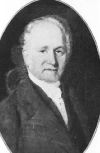 |
Peter Lomas, born 1750, died 1822. Thomas Creswick Oliver, the son of W. C. L. Oliver, only had a short connection with the business, from 1875 to 1879. On Jan 3rd, 1883 he became a member of the Manchester Stock Exchange. In 1933 he became the oldest member, and was made an Honorary Life Member. He died six years afterwards in {19 April} 1939. Alfred Creswick Oliver {author of this work}, son of Thomas Oliver was a member of the firm from 1879 to 1887 when he went to Oxford. In 1890 he took Holy Orders, and after serving in four curacies at Pilling {and} Middleton in Lancashire, Wirksworth in Derbyshire, and Eccleshall in Staffordshire, became Vicar of Barlaston, Staffordshire, in 1902. In 1918 he became Rector of Fretherne, by the river Severn in Gloucestershire. Edmund Lomas Oliver, 2nd son of Thomas Oliver entered the Firm in 1882. On Jan 3,1899 it was incorporated in the Fine Spinners & Doublers Association Ltd and of this he became a Director in —-, a position which he held till his death in 1933 {Doubts over this date; genealogy says 26 Jul 1953. However, note that the text was written in 1940!}. Percy Creswick Oliver third son of Thomas Oliver entered the firm in 1884. He died in ____. Ian Maurice Lomas Oliver, son of E. L. Oliver, entered the firm in ____. He served through the Great War, with the South Staffs Regiment and was wounded at Kemmel in April 1918. He joined the firm in 19__ and in ____ was made a Director of the Fine Spinners Association. Percy Gordon Oliver, second son of E. L. Oliver, served in the French Army in the Great War. In 1918 he joined the Firm. {Editor’s notes: Edmund Lomas Oliver is pictured twice (left and below), once in his younger years and again in his older years. The Creswick family are better known for inventing, at their premises in Sheffield, the process known as silver plating.} |
 |
|
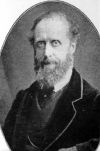 |
|
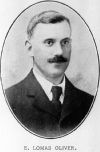 |
|
 |
{Acknowledgements}
I am indebted to the Revd. R. N. Betts former vicar of Bollington, author of the “History of Bollington Church” for many of the particulars of this history of the village. {He may have meant ‘Bollington Through the Centuries‘.}
To Mr. S. H. West, the manager of the mills at Baslow, Derbyshire, for the whole of the section dealing with the history and work and activities of the firm in that village. {This is missing from the material we have.}
To Mr. George Swindells for particulars as to the partnership of “Oliver & Swindells”.
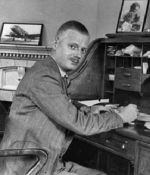 To Mr. H. V. Snape for information about the firm and the County ___.
To Mr. H. V. Snape for information about the firm and the County ___.
To Miss Spencer of Mobberley for some of the particulars of the mill, and the photograph of it. {We don’t have the photograph.}
To Messrs. Ian & Gordon Oliver {Gordon pictured left, 1950} for much of the matter relating to recent years, and access to books and documents.
And Chiefly to the Directors of the “Fine Spinners & Doublers Association” for access to the old deeds and documents and books relating {to} the Firm.
A. C. Oliver
Mobberley
The Firm had a mill at Mobberley in Cheshire. At what time cotton spinning began there is not clear. But a bill from Messrs. Kay, Engineers, of Bury, Lancashire, was seen by A. C. Oliver about 1884. The bill was for engines to the value of £1890 erected in the mill about 1859-60. An offer for the mill property for £5000, was by a Mr. W. I. Harter, of Mobberley Hall, on April 27th, 1875. The negotiations were somewhat prolonged, but ultimately accepted, for on July 23rd, 1878, a letter was received from Mr. Harter, “To Mr. J. Oliver, Dear Sir, May I ask what was the arrangement about whitewashing the Mobberley Mill outside? Did you do it, or were the tenants Kay & Richardson expected to do it? Yours truly, W. I. Harter”. The business was after turned into a Crêpe Mill. This came to an end in August, 1887; and the mill was pulled down about 1891. Miss Spenser of Fern Bank, Mobberley, has a picture of it.
An account of travelling expenses of Mr. J. Oliver shows “Sept. 17, 1871, Expenses to Mobberley, 3/6”
An Old Agreement (from the Ledger 07/1790)
Be it remember’d it is this day agreed by and between S. Gregg [sic] of Styall [sic] in the County of Chester, of the one part and Mary Crooks and Thos Lees of Manchester in the County of Lancaster of ye other pt. as follows That ye said Thomas Lees shall serve ye said S. Greg in his Cotton Mill in Styal in ye County of Chester as a just House Servt. Twelve Hours in each of the six working Days & to be at his own liberty at all other times. The Commencement of the Hours to be fix.d from time to time by the said S. Greg, for the sum of eight years at the wages of 9d per week the first year and 1/- per Week the remainder part of this time & Mr. Greg engages to find the Thos Lees with Meat Drinks Washing & Lodging suitable to one in his station during the said term, and that if the said T Lees shall absent himself from the service of the said S. Greg, in the said working hours during ye said term without his consent first obtained, that the said S. Greg, may abate his wages in a double proportion for absence; and the said S. Greg shall be at Liberty, during ye said Term to discharge the Serv.t from his service for misbehaviour or want of employ.
As written {by} their hands this 12{th} Day of July {17}96
| It is agreed for Mr. Greg To receive his Wages & Find him with Clothes |
Mary Crook Thos Lees |
Spelling
1lb of “Glew” 60 Bundels Twists. Ballance — of sundrie people
1795 1 Riem of Papers 1 Riem of Paper Law. P. Wagstaffs
115 1796 Timber Dales (? = Drals) 184 feet at 9d
1797 Dr. “Sundrie” Persons
147 1798 Joseph Wood for “Carige”
148 1798 Bateman and Sherratt Cast “Mettle” Gudgeons.
149 1800 Rent from Thos Lutman spelt also Luttman on the same page
150 1798 “Sundry” Persons
153 1799 Owing to “differant” people
155 ” “Mettal” gudgeons £1-17-2.
” ” Thomas Lomas, Jenny “Rollers”
” ” Wm. Meek, Buffalo “Hydes” £8-18-4.
153 1797 Also on page 153. Wm. Meek, Buffalo “Hides” 19/2
156 1799 “Expences” to Blackburn £1-11-6.
158 1799 William “Kirby” 40s at 3/3½ and next line but one,
” ” Wm “Kirkby” 40s at 3/7
157 1799 By “Neat” Profit £319-15
158 1799 To John Bradbury Amount “Carrige”
162 ” By Nathan Duncalf for “Pully”
165 ” To 1 saddle and plated “Stirraps”
171 1799 Lindsay 181 Linsay. Sales of Cotton.
192 ” 2 Cuppling Boxes 11/3
194 1802 John Wattson, to Glassing. 1/-
199 1801 Wm. Needham Bollington Bucles (= Buckles) & Straps
199 1801 ” ” “Lintells”
199 1801 ” ” To Glaizing” Bill 2/-
201 1802 To Ballance
201 1802 Case from Flask being “Ommited” (= omitted)
205 1803 Mr. Stuart 86 “Bundels” of Twist
215 1802 One “Barrell” Ale 18 Gall. At 10d 15/-.
220 1804 Stephen Sheldon, Bollington “Plouging, 1 day 8/-
223 1803 Geo. Harrison, Manchester “Cambric” in Aug
& in Sept (in the same handwriting) “Cambricks”
230 1803 “Blew” Skip Paper
232 1803 1 “Rap” Reel
239 1805 John Martin, Newcastle Staffordshire “Atorney”
142 1804 2 driving “pullies”
250 Sarah “Chaniler” (= Challiner)
251 S Gregg of Styal and on the 4 line of the same
Deed, “the same S. Greg.{“}
252 1798 Richd Harvey “Waist” Buyer Ashover
Nr Chesterfield
257 1804 Willm. Hatfield “Rowlar” Maker
Nr Glossop “Derbishire”
251 1805 “Movable uttensils”
Various hotels
My Father tells me how he travelled by stage coach where there were no railways. On one of these journeys to Devonshire in the winter, he described how he and his Father arrived with their beards frozen. Bills are extant from the various hotels at which they stayed. At the “Three Tuns Hotel” Tiverton, they occupied sitting room 25 and bedroom 14, as to which time there is a note that they were “The Noble Lord Palmerston’s Sitting Room and Bedroom”.
“Cumberbach’ s Hotel”, Liverpool
The “Charing Cross Hotel” (this on journeys to and from the Continent) they also stayed at the “Lord Warden Hotel![]() ” Dover.
” Dover.
These last on journeys to and from the Continent, to France, (Calais, St. Quentin, Lille), Belgium (Brussels) Germany, Austria (Vienna). At Nottingham, the Hotel usually used was the “Flying Horse“.
—— Great Northern Hotel![]() , King’s Cross London 1871.
, King’s Cross London 1871.
Queen’s Hotel, Manchester. {1 Portland Street, demolished 1974.}
St. James’s Hotel, Regent St, London.
Waterloo Hotel, 85 Jermyn St, London S.W.
That completes Revd. A. C. Oliver’s History. The remainder of this page is written by the webmaster.
Pictures
We are lucky enough to have some very good pictures of Waterhouse mill taken over a long period of time. In fact our oldest picture (immediately below) is one of the earliest in our collection, taken before the railway was built in the late 1860s.
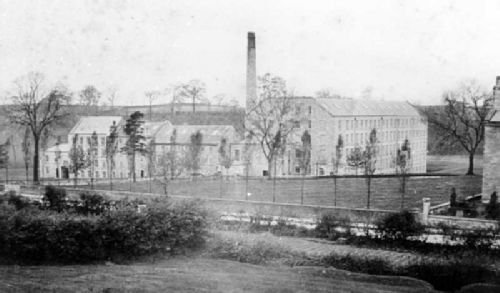 Waterhouse mill, 1860s before the railway came to Bollington. The railway viaduct that today bisects Bollington was built across Wellington Road from left to right in the centre of this picture. Notice the Methodist Manse to the right. The apparently grassy area immediately behind the Poplar trees hides the mill pond (see next picture). The presence of the boiler house chimney, suggests that water power was replaced by steam before 1869. The water wheel house remains, difficult to see, it is the lower building immediately in front of the chimney. Another feature is notable by its absence from the picture; the gatehouse, built in 1922, which existed until 2013 as the reception building for the Kay Metzeler mill. |
|
Still no reception building to the left of the entry road. However, a tower has been built on the right hand corner of the mill. This supported a water tank in the top section – to provide a head of feed for the boilers? Possibly. More likely this water was required for spray in the cotton processing rooms and possibly for toilets and basins on each floor. This tank had within it a ball cock – the ball was copper and more than 1ft in diameter![3] Bryon Holmes ‘rescued’ it when the mill was demolished – I wonder where it is now? |
|
Two pictures from the air. One might suppose that they were taken on the same day. They are both from postcards which look like two of a set. Details of the mill seem to be the same. So why are the tennis courts laid out differently – in the top picture the nets are parallel to the river, in the lower picture they are at right angles! Close inspection of the original postcard suggests that the nets in the upper picture have been hand drawn! After considering several pictures, I am also convinced that the mill pond has been extended by an artist. The picture above shows a pond taking a small part of the land – these two pictures show a larger pond with trees growing in the middle! I can’t believe that the pond was ever enlarged just as it was becoming redundant. |
|
These aerial pictures were taken in or after 1930 (the reception building was built by then). The small mill pond has now gone, although the leat remains, as it did until 2013. There have been a number of changes to the buildings along the front – compare with the two pictures above. The low building in the near corner has proved to be over the original wheel pit. The pit was exposed and removed in 2013 when the site was cleared for housing. See page on the site clearance. |
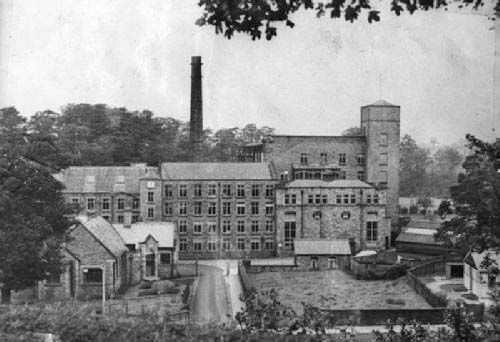 |
This picture, while looking old, was taken in the mid 20thC. The clue is the building on the extreme right which was built just before or during WWII and provided as a children’s nursery so that their mothers could go to work in the mill. This nursery continued into the 1970s before the asbestos clad building was deemed unsuitable and demolished. The reception building, built in 1922, is also shown in front of the mill to the left. Note that the building to the front right of the mill has been substantially altered as the pictures progress. |
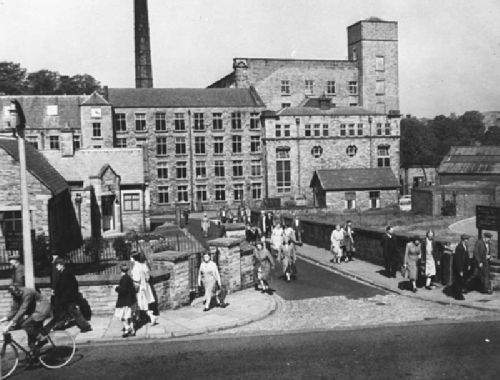 |
Workers leaving the mill – it says 12:20 on the clock, so this would be for lunch or maybe knocking off time on Saturday. Dated 1959, towards the end of cotton spinning; in fact spinning finished on 5th August 1960. Notice the light pattern on the end wall of the main building – compare with the top two pictures and it can be seen that the darker stonework has been added later. Further examination of the pictures shows that an additional row of large windows (see picture below), rather like a garret, was added to the sides of the main building to extend the top floor across the whole building. |
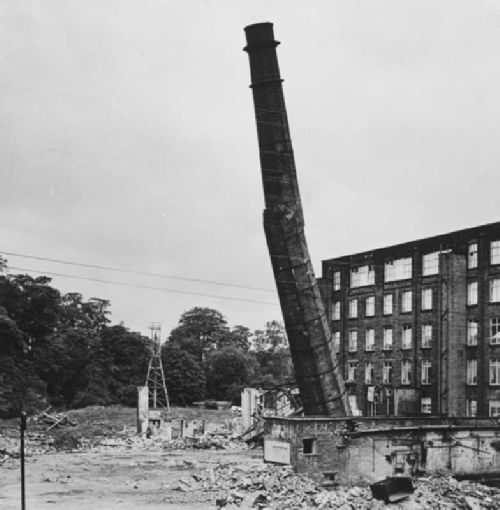 |
The end of Waterhouse Mill. It was demolished in June and July 1962 to be immediately replaced by modern industrial buildings for Kay Metzeler. The latter closed their business here in 2012 and the site was cleared in 2013 ready for the construction of c.90 new houses during 2014-17. |
Additional Information
Higher and Lower Mills were leased in 1832 to Martin Swindells and Thomas Oliver in partnership. At some point, presumably early in the Swindells-Oliver occupation, the second Higher Mill was built. This was essentially an old-style cotton mill. The rooms were taller than in the old mill, with taller windows. The new mill was wider, but still narrow enough for a single-span queen-post roof. The Swindells-Oliver partnership was dissolved in 1842.[2]
References
Clicking the reference description takes you back to the text
- History of the Firm during 150 Years, Revd. A C. Oliver, 1940
- Kerridge Ridge & Ingersley Vale, An Historical Study, George Longden, 2002
- Bryon Holmes, site plumbing engineer, 1950s
Your Historic Documents
Please don't chuck out those historic documents and pictures! Find out why here.
Kerridge Windmill
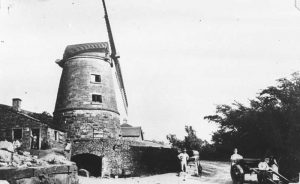 To the left of the cottages at Five Ashes, along Windmill Lane, there now stands a nice garden with a new stone wall around it. The lawn marks the spot where Kerridge windmill once stood (left). It is thought that the mill was actually second hand and came from Macclesfield Common (see panel below), part of Charles Roe’s industrial complex, developed from 1758. A description of the copper works written in the 1790s mentions ‘a large windmill for grinding the ore.‘ The copper works closed in 1801, but that windmill was converted to corn milling, and was in full use by 18061.
To the left of the cottages at Five Ashes, along Windmill Lane, there now stands a nice garden with a new stone wall around it. The lawn marks the spot where Kerridge windmill once stood (left). It is thought that the mill was actually second hand and came from Macclesfield Common (see panel below), part of Charles Roe’s industrial complex, developed from 1758. A description of the copper works written in the 1790s mentions ‘a large windmill for grinding the ore.‘ The copper works closed in 1801, but that windmill was converted to corn milling, and was in full use by 18061.
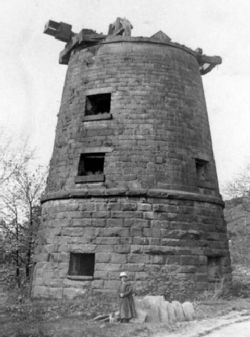 It is thought that it was then dismantled, transported and re-assembled at Kerridge in the 1830s. It is also thought that it was used at Kerridge for milling corn although George Longden writes that he has seen no evidence for this, or for any other use for that matter. It is thought to have been erected at Kerridge probably by William Clayton who had by then bought the Endon estate and built Endon Hall, and Endon House, as well as Turret Cottages and the tower on Windmill Lane, and was developing the estate in many ways.
It is thought that it was then dismantled, transported and re-assembled at Kerridge in the 1830s. It is also thought that it was used at Kerridge for milling corn although George Longden writes that he has seen no evidence for this, or for any other use for that matter. It is thought to have been erected at Kerridge probably by William Clayton who had by then bought the Endon estate and built Endon Hall, and Endon House, as well as Turret Cottages and the tower on Windmill Lane, and was developing the estate in many ways.
 The top picture shows the mill with just two sails. This would be unusual, and an older picture, c.1880 (left), shows it with the more normal four sails. It isn’t clear whether the mill was ever used with two sails, or whether the mill was out of use when the top picture was taken in the 1890s. In this lower picture, the sails appear to be without their sail cloths, and this indicates that the mill may well be out of use. This lower picture also shows that the head of the windmill could rotate to face the wind – you can see the wheel on the back for winding the head round on its track.
The top picture shows the mill with just two sails. This would be unusual, and an older picture, c.1880 (left), shows it with the more normal four sails. It isn’t clear whether the mill was ever used with two sails, or whether the mill was out of use when the top picture was taken in the 1890s. In this lower picture, the sails appear to be without their sail cloths, and this indicates that the mill may well be out of use. This lower picture also shows that the head of the windmill could rotate to face the wind – you can see the wheel on the back for winding the head round on its track.
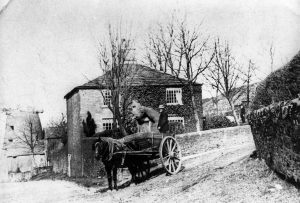 However, the windmill was out of use and abandoned by the early 1900s (above right). It fell into disrepair and became a ruin. During WWII the military were looking for stone and other rubble to build airfield runways2 and many of the derelict buildings in the Bollington district were carried away to Burtonwood airfield, just by where M&S and IKEA are today at Warrington.
However, the windmill was out of use and abandoned by the early 1900s (above right). It fell into disrepair and became a ruin. During WWII the military were looking for stone and other rubble to build airfield runways2 and many of the derelict buildings in the Bollington district were carried away to Burtonwood airfield, just by where M&S and IKEA are today at Warrington.
The site remained empty until the present garden was constructed in the early years of the 21stC.
| The design of the tower shown in an early 19th century print of the Macclesfield windmill doesn’t much resemble that of the Kerridge windmill shown in old photographs. But we can’t be sure that no stone was transported. The curved stonework of the tower would be expensive to make, not much use for any other purpose, and perhaps not too expensive to transport along the Macclesfield canal, which ran from the Common to Clayton’s tramway[1]. |
References
- Extracts taken from George Longden’s Kerridge Ridge & Ingersley Vale – an Historical Study for the KRIV project. Available from the Discovery Centre .
- William Broster, Bollington and Kerridge 1830 -1980. Available from the Discovery Centre .
Your Historic Documents
Please don't chuck out those historic documents and pictures! Find out why here.
Ingersley Clough Mill
Owner late 19th early 20thC – Alfred J King
Manager 1900-1911 – Edward Seynor Stone
History
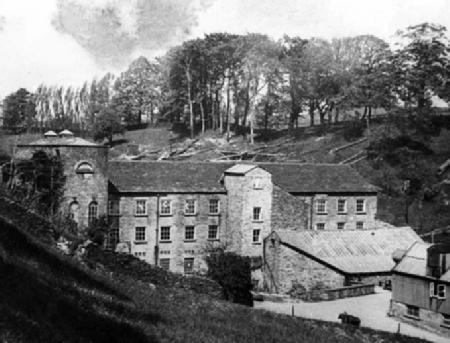
Ingersley Vale and its mills have a long and illustrious history. There were once three mills in the vale, a waulk mill (wool processing), Ingersley Vale, often known as Clough mill, and Rainow mill, lost to a fire in 1908 and with J. McNulty’s glass works on the site for many years.
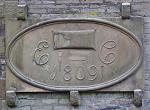
Ingersley Vale or Clough mill has been altered many times over the centuries. The remaining structure carries a date stone of 1809 (right). When originally built by Edward Collier in 1792/93 as a cotton spinning mill there was a row of cottages and the mill manager’s house, Clough House, built against the hillside close to and upstream of the mill. There was also a short row of workers cottages built over the river about 50m upstream of the mill; only the bridge upon which they were built exists today. George Longden, the well informed local historian, established that there was an apprentice house on the site, as there still is at Styal, though he could not identify its location within the complex. Edward Collier developed the mill and his date stone shows 1809 indicating a re-building. He became bankrupt in 1811 and the mill was sold to the adjacent landowner, Thomas Gaskell. It was tenanted to Chadwick, Clegg & Co. of Manchester; in 1826 J & J Fearnley plus Martin Swindells I went into partnership here, but was dissolved in 1830, all cotton spinning. In 1844 the tenants were John Leigh and others. In 1850 it was occupied by John Brice and Co., calico printers and in 1874 Anthony Scott and Co. dyers and yarn polishers. Later it was extended to four times it’s original size and occupied by A. J. King and Co Bleachers between 1878 and 1929. The original mill was accompanied by an apprentice house, one of only four in Cheshire – you can visit the restored apprentice house at Styal village.
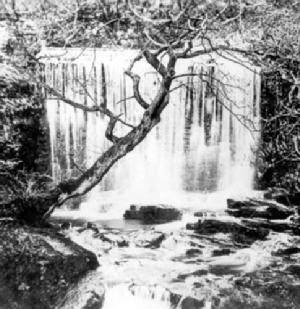
Ingersley mill was water powered until the 1950s. In 1803 the power of the river was increased by the construction of Clough pool and the waterfall (left) which stored up enough water to drive the wheel at maximum power throughout the day. Overnight the reserves in the pool were restored while the mill was idle. See the page on mill ponds. The water wheel (below) directly powered the machinery until 1895 after which the water drove a dynamo and the machinery was powered by electric motors, providing much greater flexibility in the layout and types of machinery that could be used. This was one of the very first mills in the country to be powered by electricity.

Originally there was a smaller wheel house containing two overshot water wheels, one above the other, one of 22ft diameter, the other of 32ft, designed to use the water twice. When more power was required the wheel house was enlarged to what we see today and a single 56 foot diameter by 9 foot wide wheel (right) was installed. The wheel at Ingersley mill is famous for the fact that it was, at 56 feet in diameter, the second* largest in England, and only exceeded in Britain by the wheel at Laxey in the Isle of Man![]() , and that at Diggle mill in Greater Manchester
, and that at Diggle mill in Greater Manchester![]() . Ingersley Clough mill was undoubtedly one of the most powerful water wheels installed anywhere. The power of the water was taken through the rim of the wheel enabling the light weight bicycle wheel type structure visible in the picture. Regrettably, some decades after it became redundant, the wheel was removed and scrapped by W. & A. E. Sherratt, dyers and printers.
. Ingersley Clough mill was undoubtedly one of the most powerful water wheels installed anywhere. The power of the water was taken through the rim of the wheel enabling the light weight bicycle wheel type structure visible in the picture. Regrettably, some decades after it became redundant, the wheel was removed and scrapped by W. & A. E. Sherratt, dyers and printers.
The leat supplying water from the pool to the wheel is still in place and contains a 2ft 6inch (75cm) diameter cast iron pipe to carry the water along the hillside. The aqueduct which took the water across the road to the wheel house is still in place. This is a rare and important feature of this historic site.
Graham Plant, who lives in Kerridge, remembers that his uncle worked at the mill in the early 20th century. The mill was running what were known as ‘beetles’1. These were tilt hammers that pounded the cloth in a row of containers which also contained a liquid and the process was designed to put a sheen on the cloth. Graham recalls that in his young days Rainow mill (the ‘modern’ building adjacent to Mill Lane cottages) was a cloth store and this was connected to Ingersley mill by a continuous overhead wire on pulleys and used to convey the rolls of cloth from the store to the mill.
* We, in Bollington, always regarded our wheel, at 56ft dia., as the largest in England. However, it has come to my notice (07/2019) that there was an even bigger one at 64ft dia. located in Diggle mill, Diggle, a small village to the east of Oldham.
Occupants2
1792-1821
First record of a cotton spinning mill on the site is for 1792 when there was a water powered mill with a small reservoir. The reservoir was enlarged, creating Clough Pool and a new leat constructed by 1803 by Edward Collier and this powered two water wheels, one placed above the other (description above). There was also reference to an 18hp steam engine although it is uncertain as to whether this powered the mill machinery directly or was used to replenish the reservoir at times of low water supply. The spinning mill block, upstream of the original mill, was probably built at this time. The mill was bought by Thomas Gaskell, farmer of adjacent Ingersley House (later named Ingersley Hall), in 1811, after Collier became bankrupt, and was damaged by fire in 1819. The buildings on the site at this time included the manager’s house, a warehouse, a smithy and a pauper apprentices house.
The Swindells Era, 1821-42
The mill had been rebuilt by August 1821 and the owner, Thomas Gaskell, formed a partnership with Martin Swindells I. By 1826, 330 power looms had been installed. The Swindells took full control of the site in 1830 until 1842 when James Leigh took occupation.
The printworks, 1842-78
During this period, cotton spinning ceased on the site and the buildings were converted to printing calico. It was at this time that the wheelhouse was rebuilt and the single 56 foot diameter wheel was installed, reputed to be the second largest in Britain. By 1874, the mill had changed over to a dyeworks.
The bleachworks, 1878-1929
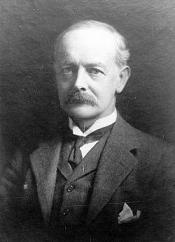
The mill was acquired by Alfred J. King (right) in 1878, in business as Bates & King, and the buildings converted to a bleachworks. The first floor of the spinning mill was removed to create sufficient headroom for the bleaching processes and a range of new buildings replaced the older structures on the site. There was considerable expansion of the facilities and in 1895, the water supply was converted to drive a dynamo, rather than the wheel, and all the processes were powered by electric motors. Joseph Stewart and some of his children worked here.
20th Century
The site was sold to Slater, Harrison & Co. and used initially as a printworks for litho and letterpress printing. In 1937, the site was taken over by a number of companies with varied but textile related manufacturing processes. More recent history has been chequered with a succession of companies in the cloth industry including dyers and bleachers renting Ingersley mill. A fire in November 1999 destroyed the roof and remaining floors of the original mill building. The last occupants of the site moved out a few years later and the whole site had descended into dereliction.
Redevelopment
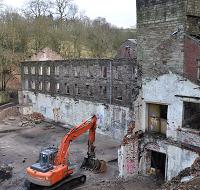
Planning permission was obtained to redevelop the entire site with new structures on either side of the original mill and the latter developed into 24 apartments. There is lapsed approval for 66 units in total.
Site A, the open ground between Rainow mill and Ingersley mill, was once a mill pond providing water to Rainow mill’s water wheel. The pond was filled in decades ago, the only relic being the waterfall behind the Rainow mill.
Redevelopment of the site began at the end of September 2010 and all the 20thC buildings were cleared. The only part left standing are the walls of the original 1809 mill and the big wheel house.
The development plans included the use of water to generate electricity. However, there are a couple of changes that will have reduced the power of the river since the 19th century – firstly the construction of Lamaload reservoir which is used to store water from the river and use it for our public water supply, and, secondly, the silting up of Clough pool so that it is in effect just a river running through to the waterfall. Clough pool has been sold off in the early 2010s to a local private owner who is developing it as a wild life reserve.
The development plans for the mill site were on hold after 2012 due to the national financial problems and was sold to HM Government’s Homes and Communities Agency. They were supposed to be getting housing built on sites such as this but little happened other than the erection of a heavy duty, and very permanent looking, steel fence around the site.
In January 2015 HCA installed scaffolding under the aqueduct to protect it from any possibility of collapsing into the road.
It took until late 2018 before HCA finally sold the site to a developer. A public consultation was held in 2019 illustrating the developer’s ideas for a new application. This generally met with approval from the community, the designs being rather more pleasing on the eye that the earlier plans. By 2023 still nothing more had been done to redevelop the site.
Martin Swindells I 3
Clough mill was the first to be taken in Bollington by the Swindells family. Martin Swindells I was in partnership with Thomas Fearnley of Stockport. “The two partners would appear to have heard something of a cotton mill in a village called Bollington. They drove into the village by way of ‘Long Lane‘, ‘Cat-ladder‘ & ‘Beeston‘ to see the Clough mill. They took the mill and Martin and his wife Hannah came and lived at the Clough in a pleasant house, the garden of which was hedged off from the road by a broad stream of swiftly flowing water, and a low stone wall.“3 More on the Swindells family can be seen on their own page.
References
- Annie Williams and the Wellbrook Beetling Mill, Cookstown, Co Tyrone NI
 .
. - Ingersley Vale LLP, document describing planned development, 2007.
- Emma F. Brooke, from notes taken in 1885.
Your Historic Documents
Please don't chuck out those historic documents and pictures! Find out why here.
A Short History
Introduction
|
In the beginning – Two corn mills
Amongst the oldest buildings in the valley these corn mills were not part of the industrial revolution at all but an intrinsic part of the rural scene as in any part of the country. Neither exist today. Bollington corn mill (14thC) was located on the river Dean just below Garden Street, just about where the small car park is in Riverbank Close. There is nothing at all left to show its exact position. This mill was water powered, receiving its head water via a long leat which came all the way from a point unknown probably at Bridgend (behind Broadhead’s garage or the Bridgend Centre in Palmerston Street).
The second corn mill was certainly operating in the mid 16thC and was later a paper making mill before being redeveloped into Rainow cotton mill, which has itself been lost in 1856 and again in 1908 and replaced by mid-20thC industrial buildings presently housing a pet supplies retailer and Pumping & Technical Services, pump engineers. The waterfall that held up a mill pool is readily visible behind the workshops but it is doubtful whether this originates from the corn mill. It is more likely to have been built with the first Rainow mill; maybe built over an older weir.
Early cotton mills
The first cotton mill in Bollington was Oak Bank mill, built in 1784 by George Antrobus between Queen Street and the bottom of Shrigley Road, where Hamson Drive is today. In those days it is thought that Queen Street continued through the mill site to join Ingersley Road and the first part of Shrigley Road was then only recently built, the way to Pott Shrigley being via Ingersley Road, Smithy Brow and Spuley Lane. At this time there was probably a ford or a minimal bridge over the river at the bottom of Shrigley Road because a mill manager’s house was built 100m up Shrigley Road in 1794 and named Newbridge House. Over the following two centuries Oak Bank mill was burnt down (1882), rebuilt, had its use changed several times, and finished up in dereliction, being demolished in the late 1990s, after which the present housing estate was built. The Harrop brook runs under the site in a big stone culvert. Oak Bank mill had its water supply stored in the mill pond beside Shrigley Road, still existing in moderate condition today.
In the late 1780s Peter Lomas built the first Waterhouse mill. He had previously been operating a tannery approximately where Brook House is today in Wellington Road (next to the Medical Centre). Lomas married a daughter of the Oliver family and the business became Olivers. The mill was burnt down around 1800 and rebuilt to become the premier fine cotton mill in the world.
Mills everywhere
Bollington only exists as a town today because the valley was a good place to build, power and operate cotton mills. Alas, the remaining mills no longer have anything to do with cotton but we are certainly left in many cases with fine heritage buildings that have fortunately found other uses. We also include in this list some Rainow mills that were important to the area. In alphabetical order …
- Adelphi mill, (1856) cotton mill, today thriving commercial units;
- Bannister’s, see Owlhurst mill;
- Beehive mill, (c.1862) cotton spinning, demolished after 02/1912;
- Bobbin mills, Queen Street and Beehive, (c.1800) both demolished long ago;
- Bollington mill, (14thC) thought to be the first in Bollington, a corn mill; no trace remains;
- Clarence mill, (1830s) cotton mill, first mill built to be steam powered, became the biggest, today part apartments, part commercial;
- Cow Lane mill, Rainow, cotton mill, little remains, excavated as part of the KRIV project, 1860s picture;
- Defiance mill, Queen Street, (1800) cotton, later minerals grinding, then part of bobbin mill, followed by mineral water bottling, now converted to domestic use;
- Fulling mill, wool preparation, location not known, but possibly with the Waulk mill in Ingersley Vale;
- Higher mills, two mills here, (1st c.1789, 2nd 1830s), cotton mills, followed by many other uses including hat makers, brewery and dyers, Dyers Close housing today;
- Hough-hole mill (White Shop), Rainow, cotton mill, completely gone, only the pond remains, 1860s picture;
- Ingersley Vale or Clough mill, (c.1800) cotton mill, bleaching, derelict after 1999 fire, planned site re-development as domestic properties;
- Kerridge Windmill, at Five Ashes, purpose unknown, derelict then demolished in WWII;
- Lower mills, (1792) cotton mill, Tullis Russell paper coating mill today, some old some new;
- Lowerhouse mill, (1818) cotton mill built by Philip Antrobus, occupied from 1832 by Samuel Greg Jnr; today Slater Harrison paper coating mill;
- Oak Bank mill, (1784) cloth printing mill, all gone, today Hamson Drive;
- Owlhurst mill (The Owlhurst), Whitaker’s [(flour) Bag] mill, Turner Street, later Bannister’s furniture mill, burnt out in 1990s, apartments today;
- Rainow mill, Ingersley Vale, probable site of an early corn mill, then a paper mill, then cotton and silk, burnt down in 1856 and again in 1908, today the site houses a joinery workshop and engineering works;
- Sowcar mill, (1802) cotton mill built by George Antrobus in Sowcar meadow, gone by 1832, hardly a trace remains, no picture;
- Turner Heath mill, small works owned by Philip Antrobus (1829), unknown purpose, part of a wall remains;
- Waterhouse mill, (1791) burnt down 1800, re-built, first big cotton mill, later Kay Metzeler foam manufactory, today a housing estate;
- Waulk mill, Ingersley Vale, wool preparation; location uncertain, no trace identified;
- Whitaker’s, see Owlhurst mill above.
Not all of these were built as cotton or silk mills of course. At least three were corn mills for some or all of their time, at least one was a paper mill and the names of others indicate their purpose. Most mills have changed their use, with Ingersley mill, for instance, having more than a dozen uses over the years.
And, of course, we could not have mills without the people who had the foresight, inventiveness and courage to invest and build these fine structures in the hope that they could establish a sound business that would make them some money. In some cases they made a good deal, and some spent a lot of it on improving the town. In other cases they ended in the bankruptcy courts or even in jail for their debts. See the people pages for more on this.
The descriptions of the mills are taken from the extensive researches carried out over many years by the Bollington Civic Society History Group, Wilmslow Historical Society Industrial Archaeology Group, and by further later work by George Longden for the Kerridge Ridge & Ingersley Vale project (KRIV). The historic pictures come from the Civic Society collection which can be seen at the Discovery Centre and online![]() .
.
The History Group are no longer active but if you would like to be involved in local history research then please contact the webmaster.
A full description of a typical cotton mill, the factory system![]() and their development through the industrial revolution can be found on Wikipedia, as can a good description of the textile industry
and their development through the industrial revolution can be found on Wikipedia, as can a good description of the textile industry![]() . A description of the cotton carding and spinning process
. A description of the cotton carding and spinning process![]() can also be found on Wikipedia. A list of the typical jobs and skills to be found in a Bollington cotton mill is also available.
can also be found on Wikipedia. A list of the typical jobs and skills to be found in a Bollington cotton mill is also available.
Probably the best history of Bollington’s cotton mills may be found in the book East Cheshire Textile Mills, written by Anthony Calladine and Jean Fricker, published by the Royal Commission on the Historical Monuments of England, 1993.
Your Historic Documents
Please don't chuck out those historic documents and pictures! Find out why here.
Ingersley
‘Old’ Bollington | West Bollington | Bollington Cross | Lowerhouse | Gnathole | Kerridge | Ingersley
Ingersley is in Rainow parish. However, it is physically very much part of Bollington and what happens to Ingersley Vale is of acute interest to Bollington.
The Bollington /Rainow boundary crosses Ingersley Road beside the Poacher’s Inn at Mill Lane. Sowcar farm across the road is in Rainow as is the cottage on the corner. The boundary runs along Mill Lane, the bridle road beside the Poacher’s, then across to the Bollington side of what used to be the bowling green but is now a new development of houses, across the mill pond and straight up Kerridge Hill, then all the way along the top.
This means that the major part of Ingersley Vale is actually in Rainow. Ingersley Vale is interesting for its heritage. Opposite the bowling green site is a fine old stone house. On another side of the green, on Mill Lane, is a row of stone cottages, all beautifully restored.
There is no road access from Ingersley Vale to Rainow, just a very good footpath.
Rainow Mill
Along Ingersley Vale, beyond Mill Lane, is the green corrugated iron workshop with another business behind that. On this site once stood Rainow Mill, from at least 1611 (and possibly much earlier) a corn mill, later a paper mill, then a cotton mill, a silk mill and finally back to cotton. It was probably re-built several times over the centuries, including after a major fire in 1856, before finally being burnt to the ground in 1908. Lack of proper insurance ensured that it was never rebuilt after that.
The mill pond was located immediately behind the mill, above the weir, where the level waste ground is today.
Ingersley Mill
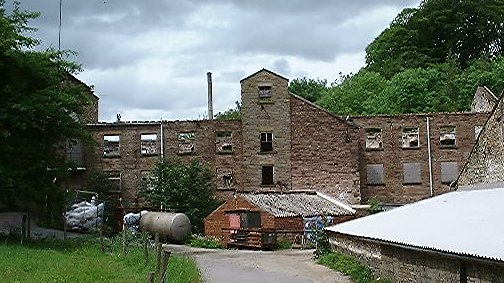 The next premises up the valley is Ingersley Vale or Clough Mill, usually referred to today simply as Ingersley Mill.
The next premises up the valley is Ingersley Vale or Clough Mill, usually referred to today simply as Ingersley Mill.
The original building was seriously damaged by fire in November 1999. The remains and the preservation of this listed structure are presently a major concern and ideas were proposed in the 2002 Kerridge Ridge & Ingersley Vale Heritage & Countryside Project![]() (KRIV). The mill is located across the narrowest part of the steep sided vale, being only about 150 feet across. A huge wheel house adjoins the mill – the block behind the tree on the left in the picture. A very narrow lane, clinging to the hillside, passes the mill and provides access to properties further up the vale. A large number of very poorly constructed 1960s industrial buildings adjoined the mill on both sides up and down the vale. These have now all been demolished in preparation for a housing development that never happened. There was also the remains of older out buildings – behind the mill one looked as though it might have been the Apprentice House that is known to have been built on the site. A part of the building on the extreme right of the picture is the warehouse built in the 19thC on the location of much earlier mill workers cottages and the mill manager’s house, all now gone. The shell of the main mill building is now derelict and dangerous and is expected to be demolished, leaving only the wheel house which is very stout.
(KRIV). The mill is located across the narrowest part of the steep sided vale, being only about 150 feet across. A huge wheel house adjoins the mill – the block behind the tree on the left in the picture. A very narrow lane, clinging to the hillside, passes the mill and provides access to properties further up the vale. A large number of very poorly constructed 1960s industrial buildings adjoined the mill on both sides up and down the vale. These have now all been demolished in preparation for a housing development that never happened. There was also the remains of older out buildings – behind the mill one looked as though it might have been the Apprentice House that is known to have been built on the site. A part of the building on the extreme right of the picture is the warehouse built in the 19thC on the location of much earlier mill workers cottages and the mill manager’s house, all now gone. The shell of the main mill building is now derelict and dangerous and is expected to be demolished, leaving only the wheel house which is very stout.
Ingersley Clough pool, the leat and the waterwheel
The water wheel at Ingersley Mill was fed by a leat from Ingersley Clough pool. All remains of the leat can be seen today. The leat is connected to the mill by the aqueduct across the lane beside the wheel house. If you walk along the lane you will see the leat at the top of the field. At the end of the field it emerges from a culvert that carries the water beneath the cottage gardens. Walk up the lane past the cottages and you will find Waulk Mill House and Waulk Mill Farm on your left. Opposite them is the most excellent waterfall over the dam that retains the clough pool. The pool is very overgrown these days and contains a relatively small amount of water. The pool is now in private ownership and the owners have made great efforts to manage the site and encourage all forms of nature.
The waterwheel at the mill evolved with time. It was originally two wheels, one above the other. Later these were replaced with a single wheel, rather like a gigantic spoked bicycle wheel, about 52 feet in diameter and 10ft 6 inches wide. This made it third only in size to the Laxey wheel in the Isle of Man and another at Diggle mill in Lancashire.
The wheel was later replaced by turbines connected to electricity generators. This mill was one of the very first in the country to be electrically powered.
Ingersley Waulk Mill
Nothing remains of this mill, which was part of the woollen industry. The name remains in the properties at the southern end of Ingersley Vale. It is thought that the mill may have been located in the flat riverside field below the present cottages.
Thanks
I am indebted to leading local historian George Longden for much of the above information. George has undertaken a remarkable amount of research into Bollington, its origins, industry and people, and has, sometimes with others, published a number of extremely interesting books about the history of the town and surrounding area. Checkout the Books page where you will find his reference list.
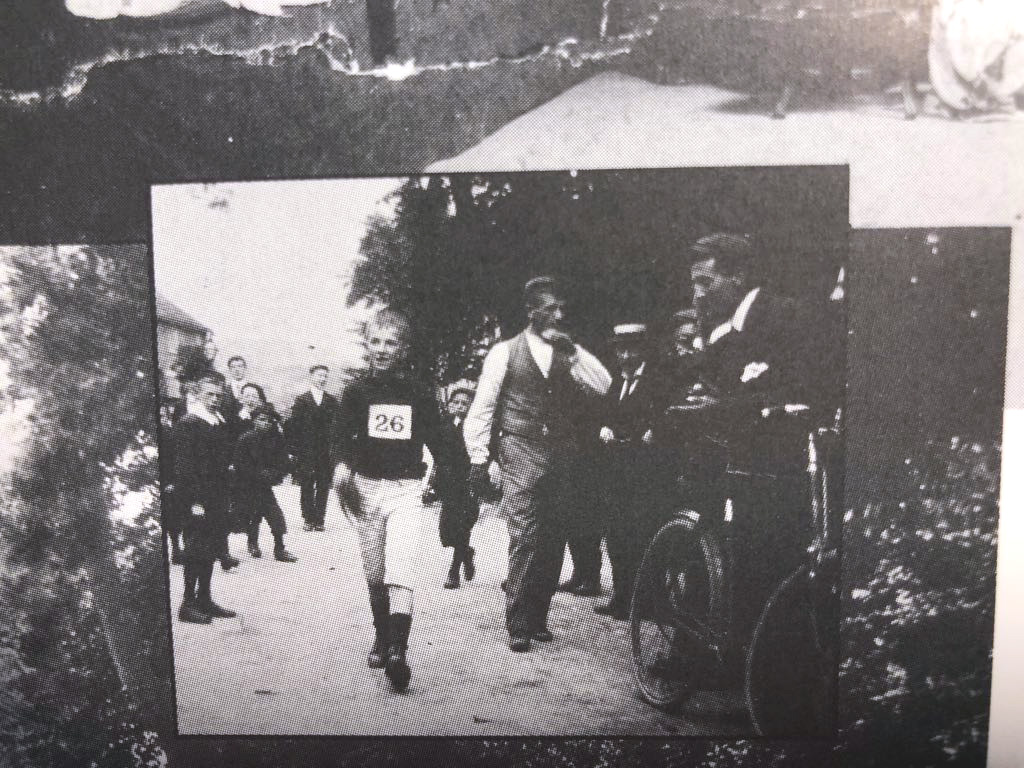
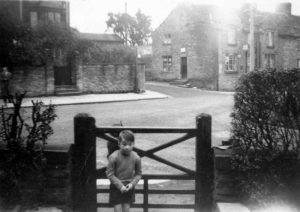


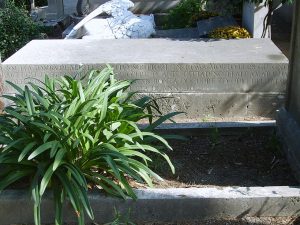
 Revenge of Achilles
Revenge of Achilles 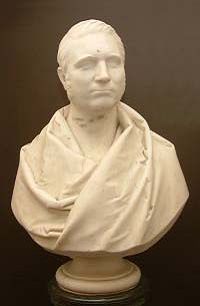
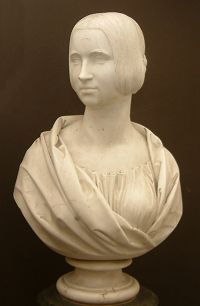
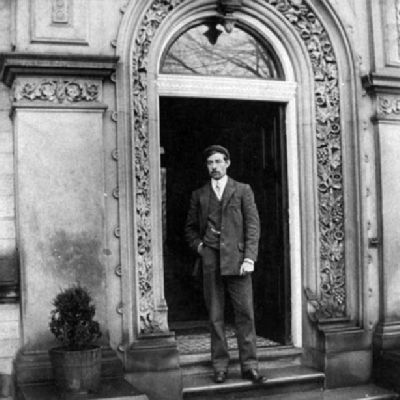
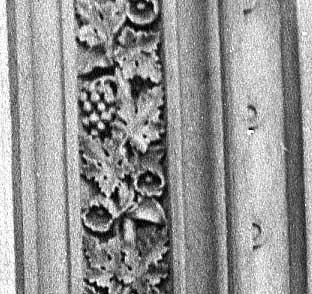
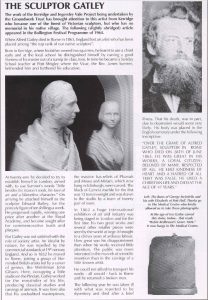
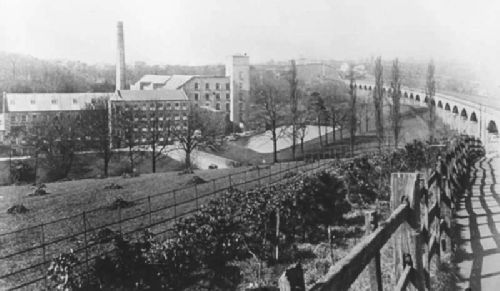 At
At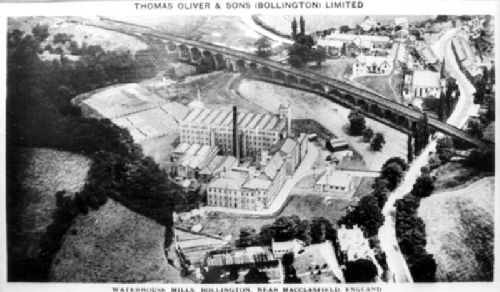

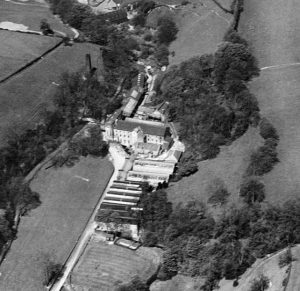


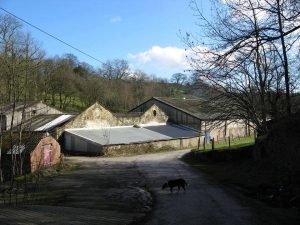
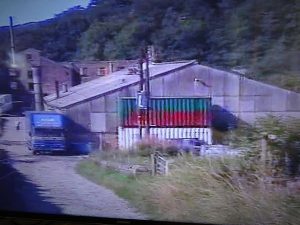
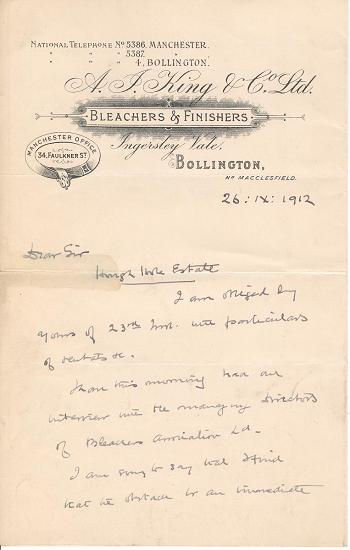
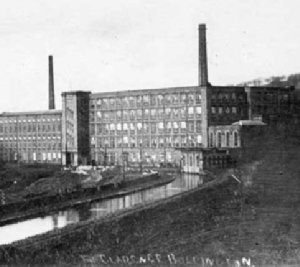 The industrialisation of the happy valley that became Bollington occurred between about 1760 and 1950. Before that time there were two, both corn mills producing flour. After 1950 the industry rapidly ran down with closures, demolition in the case of Waterhouse mill, and conversion to other uses, during the following fifty years or so. Today (21stC) Bollington has several fine mill buildings with uses varying from domestic accommodation to hi-tech offices, as well as manufacturing – paper coating at both Lower mills and Lowerhouse mill being the main industry.
The industrialisation of the happy valley that became Bollington occurred between about 1760 and 1950. Before that time there were two, both corn mills producing flour. After 1950 the industry rapidly ran down with closures, demolition in the case of Waterhouse mill, and conversion to other uses, during the following fifty years or so. Today (21stC) Bollington has several fine mill buildings with uses varying from domestic accommodation to hi-tech offices, as well as manufacturing – paper coating at both Lower mills and Lowerhouse mill being the main industry.